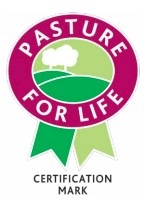If you would like a printed copy of any of our back issues, then they can be purchased on Farm Marketplace. You can also download the PDFs or read online from links below.
-
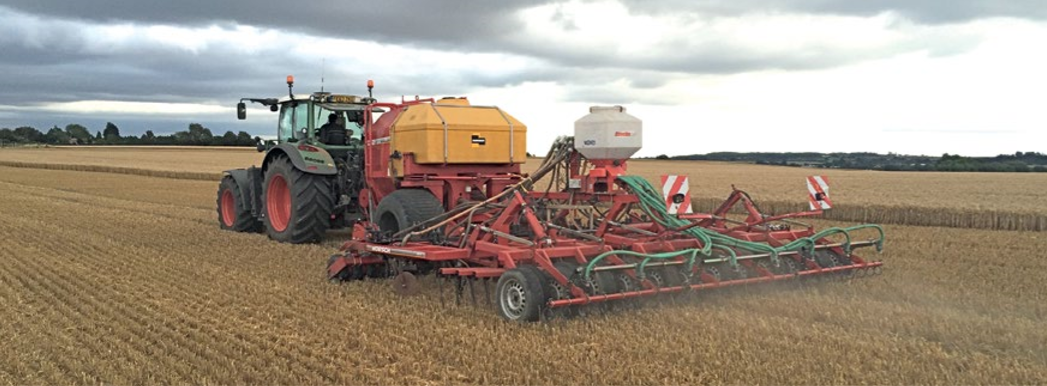
How To Start Drilling For £8K
Clive Bailye’s seed drill of choice is his 6m John Deere 750A , which has been used exclusively for 3-4 seasons. Last year, with an increased acreage, the founder and publisher of this Direct Driller magazine thought a second seed drill was necessary. Having just the one machine was a risk and in a difficult season would mean drilling was delayed. He looked around and found a good condition Horsch CO6 tine drill advertised in Germany.
Words and pictures by Mike Donovan
After delivery he rebuilt the coulters to a narrow profile so as to reduce soil disturbance. He says the tine drill is very useful driling after straw crops such as osr and also through the straw on second crop cereals.
Buying the drill from a German farmer was not particularly complicated, and provided him with a higher spec machine than Horsh sell in the UK. The seed dart tyres are much wider, and the machine is fitted with blockage monitors as well as full width front packers and also a liquid fert application system.
A sheaf of photos were taken, and Clive then asked for some of specific parts to show wear. The deal was done at under £5,000 which Clive says is the market value of these machines which are too large for small farmers to buy. Original owners like to buy new and sell when the machine is still in good condition.
Narrow tines with wear tiles
@Clive knew he wanted to make changes, substituting the Horsch tines and coulters for something far narrower, and has ended up getting his own design of tine made, which has a wear tile made from Ferobide, far harder than tungsten. The drill is on the farm primarily for osr and 2nd crop cereals drilled into chopped straw and the 25cm spacing is okay for these crops.
Comments on Clive’s on-line forum, TFF, said the drill many not be so good with beans, as the slot is a mere 12mm wide. And in barley the spacing may well be too wide as it needs to be thick. Clive points out that the seed pipe can actually be a bit wider than 12mm as it is in the shadow of the point. It would be good to have the option of using it for beans.

Above left: The cheap CO6 is being calibrated ready for its first outing

Above right: The adapted Horsch is being filled by the home built drill logistics trailer with seed and liquid starter fert.
Getting around the German instructions
The Horsch came, of course, with a control box and instructions in German. More on-line discussion revealed that English instructions were available on the Horsch website, and another explained that Horsch was sourcing some of these parts from Agton in Canada anyway. Zealman from New Zealand explained that the button marked with callipers should be held down for around 5 seconds. The menu is where you adjust the tramline sequence, valve layout and row numbers.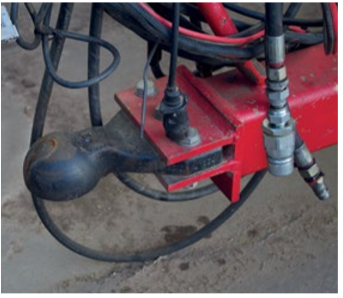
Ball hitch is a continental standard and provides a positive connection between tractor and drill

The Stocks Wizard has a rotor modified for Avadex which otherwise leaks everywhere
A Stocks Wizard is on the back of the drill and used for Avadex. Here again the knowledge of actual farmers is helpful. Alistair Nelson warned that the rotor and the surrounding shroud need to be changed, and he got good advice “from Rick at Stocks”. Clive has the same setup on the 750A and says that the Avadex leaks everywhere unless the modification is made. The drill was acquired and modified in 2016 and the results have been excellent.
The machine went through the residue without many problems and having the second drill has meant more timely planting. Clive has shown that moving into No-Till is not the expensive exercise so many farmers think it might be. The total cost, after modifications which included replacing all tines and coulters, was under £8,000.
Author Mike Donovan writes: we have featured a number of home made direct drills in @Practical Farm Ideas, and are always interested in seeing more. Please contact mike editor@farmideas.co.uk or 07778877514.
-

Drill Manufacturers In Focus…
FOCUS TD OFFERS STRIP-TILL IN NEW 3M WORKING WIDTH

HORSCH has launched a 3m version of the proven Focus TD strip-till line to offer a solution for smaller operations to combine strip tillage and sowing. Following customer requests for a smaller machine, the 3m model has a steel hopper with 3500 litre capacity with a partition of 60:40. In addition, a MiniDrill with an additional 400 litre capacity is available.
MiniDrill increases productivity
The MiniDrill offers a third component in the application process and increases the productivity of the machine. In the case of OSR seeding, the rape seed can be metered with the MiniDrill and the two main hoppers can be used for fertiliser, increasing the seeding output of the Focus by 40%. If the MiniDrill is used as an addition to the PPF system, the seed outlets are located in the seed bar area and can be used to apply slug pellets, for example.
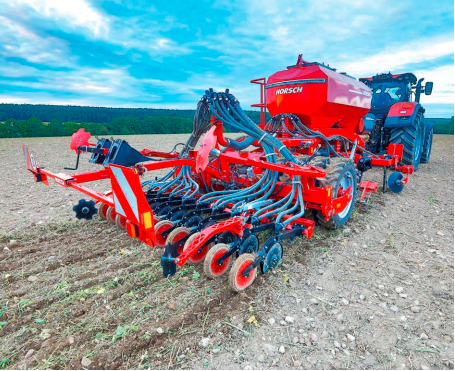
The Focus TD has been designed to be an uncompromising solution for strip and conventional drilling in one machine. The TerraGrip tine system creates a deep loosened area and fertiliser can be placed shallow, deep or 50/50. The tine cultivation frame can be replaced with the DiscSystem to create a compact rotary disc harrow.
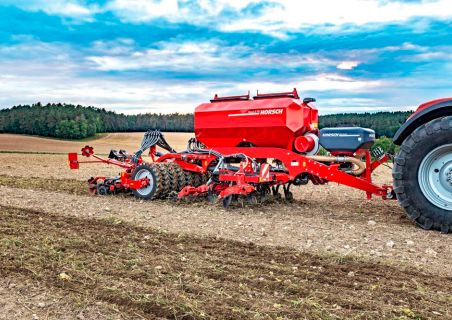
Further options
As an additional choice to the wellproven TurboDisc double disc coulter, the new TurboEdge tine coulter can be specified. It is suited to row spacings that are larger than 25cm for rape and beans. Especially suited to heavy soils or those with a lot of residues on the surface, the seed tine offers exact placement of the seed. Even if there is limited cultivation work, the TurboEdge coulter shows its advantages. In other conditions, the TurboDisc coulter continues to be the best choice for optimum precise seed placement.
A crumbling unit, instead of the levelling discs, in front of the packer provides a fine earth in the seed strip and is particularly effective on medium and heavy soils. Due to its open design and small diameter, coarse soil is easily crushed and the self-cleaning effect on sticky damp soils is excellent.
-
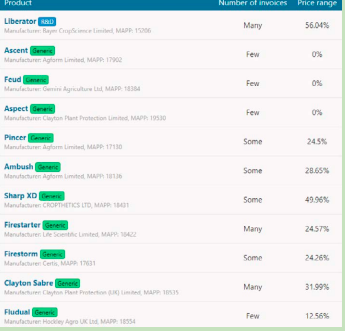
The Buying Game
Written by Chris Fellows
Last month I got chatting to a driver delivering chemicals to the farm, and he got around to asking what I was doing that day. I was in fact working on a new service we are developing called Farm Compare, which is designed to help farmers buy more efficiently. I wasn’t sure how well this would go down, but his response was interesting. “Great” he said. “My next five deliveries are single drums of chemical to each farm. Maybe you’ll teach them to buy in more sensible quantities”. Farm deliveries are peculiarly wasteful. The delivery driver understands that dropping off a single drum is far from efficient; and the average housewife knows that buying a four pack of baked beans is more cost effective than buying singles as well. But despite this knowledge this driver was going to drive 45 minutes to get to the five different farms. That is not efficient, and the cost of that inefficiency is being paid for by farmers. In one way or another.
What is the issue?
The fault here doesn’t totally lie with farmers who like to get the goods they need when they need them. They don’t know that they are paying a premium price for getting single drums, because they don’t know the quantity discount. And the distributors pride themselves in their ability to deliver products as an when needed, one at a time if required. The scenario gets worse as the farmer only orders exactly what he needs for any job. In industry it is ‘Just-In-Time Procurement’. The supplier holds the stock and delivers little and often. It can be efficient for the farmer but is massively inefficient for the distributor. If so, why should the farmer be interested in making a change to this supply system? The reason is that every supplier has to load the distribution costs on to the price of the product. Everyone is a loser.
Enter Farm Compare
Here is a free price comparison and product lookup tool for farmers for crop protection products. It’s a simple idea which depends on the involvement of lots of farmers. If you contribute the prices which you have had to pay for product, you can then see the prices others have paid. It also shows the quantities in each order, revealing the quantity discount. There is no cost to use it.
The aim of Farm Compare is for you to see not just the price, but how was that price achieved. what quantities are ordered generally. Where was the delivery location? Remote or central? How many packs were ordered to achieve it? When was it? In high season to be used immediately or off-season? Was the product R&D, a generic or a parallel. There are lots of questions and Farm Compare gives you the answers. You can even compare prices from one equivalent product to another. That’s not to say they are exactly the same, just that they include the same chemistry.
Knowing this information helps you buy better. Buying all your requirements product once and early in the year (by guessing your need) could have been the way to get the best price. But you also might have over-ordered and left with stock that could deteriorate. The buying risk is moving to the farmer, so the price paid should reflect that. For instance – most of us will use something like a Liberator. Did you know there have been 29 different products produced using the same chemistry in the last 18 months? That’s right, 29 equivalents for just one product. And the price difference on all of them are different. Here are just a few of them:

To see a price range is normal. You would expect there to be a difference between buying 1 pack and 50 packs. As the prices quoted also often include delivery, you might also expect a differential by location. For that reason, we have included filters for location. The above data is national, but you can also run a search for your region. This table is for the East Midlands:
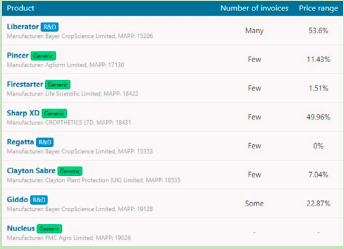
Obviously, the more filters you apply, the fewer number of overall prices there will be to compare with, but the more relevant those prices will be for you. By the way, everything you are seen so far is available to all, even if you don’t want to see more detailed information. If you just want to see what the equivalents are, then you can run those searches as often as you want. During the testing phase I’ve used it a lot myself, so we hope it will be a really simple but useful tool in every farmer’s pocket. If you have submitted prices then you can move to the next page, which gives you even more detail. This is what more detail looks like:

That however is just the prices for that product, and most of us are happy to use equivalents. The equivalent prices are also really useful. This is the graph Farm Compare produces to help you:

If you lived in the East Midlands, then the best prices were for Sharp XD, but there was also quite a range and that product. Pincer and Ambush gave the best average prices, with very little deviation from these prices. All prices are displayed per litre or Kg, this is so you can compare the prices where products are supplied in multiple pack sizes. Where you have bought that product or an equivalent, then your price also shows on this graph.
As a farmer you can run this same search for every product you bought last year if you want to do some benchmarking on farm performance. You can also run a search for every product you want to buy. Giving you a bit of market information to help you chose what products and where to buy them. Did you even know there was a product called Regatta? I didn’t before writing this and I feel I get to see a lot of crop protection products being involved in marketing them. Farm compare gives you all this information to help you with your buying decisions. It also helps you learn product names!
Price Transparency
The aim of this system of course is to create price transparency. This is the natural evolution of all markets. Let’s face it, if you were buying a TV you would be checking different sites, Google shopping for instance to see where the same product was for sale at different prices. You might not even buy the cheapest. You might buy the one that can deliver tomorrow. You might buy the one from the company how give you a line of credit. That’s normal in our lives. However, you can buy a 60 inch TV for the price of a couple of packs of Liberator, so why not take the same care when buying your crop protection products? Farm compare is a bit like Google Shopping for crop protection products, with a bit more information thrown in and just like all Google services it is all available for free. In fact, you can find quite a few crop protection products on Google Shopping already.
What next?
While you can now find out the best places and times to buy every product, the optimum buying year cannot really be achieved. For a start, we may not have accounts with all the suppliers, then we probably don’t need products in the volume to get the optimum price. But we have a guide for every product. But what would be useful is to know more macro decisions, such as:
• How much in total am I buying above or below the group average?
• If I was to buy from one supplier, who would be the best supplier for me?
• If I was to select two suppliers, who should I buy from?
• If I am a supply customer paying £15/18/20 a hectare walking fee (insert your own figure), would I be better off as a serviced customer?
• If I am a serviced customer, what could I afford to pay per hectare as a walking fee and move to supply only and be better off?
Strategy questions like this, will help farmers guide their businesses. Dealing with one or two suppliers is practical, dealing with 10 isn’t. Not impossible, just not practical. Being serviced also gives you more guarantees than being supply only, so that carries a price, even if it’s more like an insurance policy. These are all decisions we need to make as farmers, all it requires is a transparent system like Farm Compare to allow us to make them. Within a year, the system will also be able to answer these questions for you. All you need to do, is make some time to use it.

-
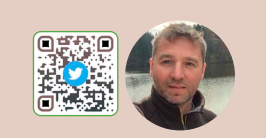
Farmer Focus – Clive Bailye

Fake news?
Harvest 2020 was never going to be great, the perfect storm of a wet autumn and winter followed by a spring drought was always going to end in disappointment. When it came to yields any usual excitement and anticipation was replaced by simple desire to clear ground of such uninspiring crops and start again in the hope of a better season next year, an endless instinct of optimism that seems bred into all farmers. As combines started rolling our fears were confirmed and average yields were the lowest I have ever been responsible for. We consoled ourselves that weather had placed the outcome beyond our control and at least the right management decisions had been made to reduce spend in attempt to maintain margin. Prices are good but almost theoretical when you have so much less to sell, solace only found in a decision made to carry over harvest 2019 milling wheat taken during the spring drought once it became clear that yields were surely going to be lower and storage space un-stretched at harvest.
As a business that farms mostly land belonging to others under contract farming agreements there is always a day of reckoning post-harvest when the results are announced. We work closely with our landowning clients to keep them well informed about crop prospects and management decisions throughout the growing season, they were under no illusion as we entered harvest that this year those results would not be great. They had been consulted when we decided to cut back on input spend and agreed it was a wise strategy given the circumstance of the season, aspirations had been firmly aligned with likely reality…………… that is until they read the wider farming press and listen to the “pub yield” chatter of other farmers. Little regard is given to how such miracles have been achieved, their different locations, soil types, input use, irrigation, and dare I say even honesty, instead they are simply held up as evidence of failure of their own farm or contractor to perform.
It really isn’t helpful, in fact the lack of honesty or disclosure of all the facts is damaging not only to contractor / farmer relationships but also in the bigger picture of leading land agents, suppliers and even policy makers to conclude farmers can afford the ever inflating prices we are subjected to. In a year where I believe my management was better than it has ever been, and my team worked harder than ever to achieve their goals, it’s saddening that success is judged as failure because of a boastful few.
So, are farmers dishonest? Does agricultural media print fake news? I like to think not, it is more a case of selective reporting and agenda surely? In the case of a farmer maybe an genetic ability to “forget” after a few pints or a sloe gin too many about the 100ac of OSR that was ripped up and replaced with spring barley whilst boasting how they “averaged” 5t/ha of OSR this year ? or maybe recounting the cost of irrigating that 15t/ha wheat crop is best forgotten along with the myriad of snake oil products and top of the line fungicides his agronomist talked him into using to achieve that headline number seen momentarily as it flashed up on the uncalibrated yield monitor when the Lexion’s hydrostatic stick was jerked backwards? On occasion the reason for yield dishonesty can be a little more calculated however, in a competitive land rental and contract farming market would the land owner be better off if they farmed the estate for them and got them these better yield they boast of? Fake news, it seems, is not only reserved for American presidents with an agenda.
Sadly, I am a little more sceptical about just why these tales of success proliferate so much in farming media. Put simply, success sells, it attracts advertisers who flock to be associated with or highlighted in the aspirational success story, and they pay the bills. It runs much deeper than just “pub yield” stories however and over the last decade or so we have witnessed the death of any independence in farming media replaced by seemingly endless paid editorial, the value of which really is questionable to our industry. Rather ironically (as founder of www.thefarmingforum.co.uk) from me I blame the internet which has all but taken over as the primary source of information for most of us, squeezing those existing publishers harder to sell their souls and integrity. Maybe I should accept some personal blame here! It’s all harmless though, right ? No one really takes all this to seriously? Well it’s certainly does not feel that way when sat down with contact farming customers in year-end meetings that much is for sure.
It is not just yields that get exaggerated though and as regenerative agriculture gains in popularity it will inevitably attract its own fair share of fake news. As farmers move away from more conventional inputs, we can be sure that an array of “soil friendly” products and machinery will compete for the same cash. Products are increasingly discounted to “influencer” farmers in exchange for good reviews and recommendations, cheap and powerful marketing for those that know how to use it. Never has it been more important to have access to independent facts and value our integrity.

It now seems clear that DEFRA’s ELMs will accelerate uptake of conservation agriculture and this will be where the money is in the future. I have just listened to George Eustice’s speech that mostly seemed to announce that there would be a series of announcements to follow but did make reference and commitment to capital grants. I have never been a fan of grants, probably because I have never yet managed to meet any criteria to get one (I’m not bitter, honestly !). Mostly because they tend to penalise innovators, and encourage those that would not otherwise have adopted change to spend for no better reason than acquisition of something new and shiny at a discounted price. This fills me with fear in the context of conservation agriculture where those with experience understand that mechanisation changes are only really a small part of what is required in a successful system, I hope these proposed grants are smarter in their targeting used to invest in knowledge exchange and re-education and do not simply serve to further line the pockets of our suppliers.
As no-till farmers we must also be careful to not over exaggerate the benefits of it brings, we all know the cost savings and environmental advantages it can deliver, but we must remain conscious of conformation bias and look to back up what we do with good solid data wherever possible. We must be realistic about size of markets for some of the niches on the fringes. I love the idea of agroforestry and incorporating more tress into our farm and have looked at various ways to derive income from them, harvesting nuts and quince etc was suggested as a possible solution to me but seriously just how big is the UK market for quince? There are maybe niche opportunities out there, but the markets are small and would fail quickly if we all jump in at scale.
I hope that policy makers are not blinded by the impressive, extreme case examples of enviable success some have achieved on the fringes. Agroforestry, rewilding and clever value added direct marketing should not be seen as some kind of blueprint for ELMs; instead the creation of a scheme more achievable by the majority of us trying to produce commodities competitively for global markets alongside our management and regeneration of the countryside and environment will hopefully result. Over the years we have been farming under conservation agriculture principles, we have without doubt added benefit to wildlife, environment and climate, with cheap food the only output we sell though there has never been any direct reward or premium attached to the natural capital provided and I look forward to ELMs putting that right.
The relief of clearing the uninspiring crops of 2020 came with a hangover, later drilling and replacement of winter rape with spring linseed led to a later harvest which reduced opportunity for cover cropping and forced later drilling dates, but surely we would not get another wet autumn?
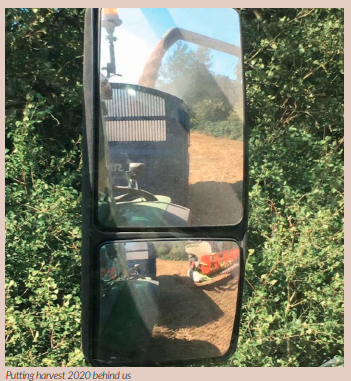
Ironically and without planning to do so our first fields of wheat were established on 22nd of September, the same date as they were a year previously, and then equally as coincidently it started raining again. A couple of weeks passed without a wheel turning and thoughts of 2021 becoming a repeat of the nightmare that was 2020 were hard to ignore. Unlike some parts of the country, however, luck was with us and in midOctober the rain stopped and gave us the 10 days we needed to get wheat, barley and rye drilled into reasonable conditions, the sense of relief was strong, the thought of another year like the last just too horrible to imagine for all involved.
I know our memories can sometimes be short and the last 12 months serve an extreme example, but it really does feel like the windows of opportunity to establish, treat, and harvest crops are getting tighter. Without the extra capacity gained moving from a 6 to a 12 m drill has bought us we would once again find ourselves missing targets and compromising cropping because of weather. If climate change is real, we as farmers are very much on the front line and will quickly become its first victims if significant steps to put things right are not taken.
I’m conscious this is an unusually negative article for me, but the last 12 months have been tough. No farmer that cares, likes to grow a crop they are not proud of, throw in a global pandemic and looming economic armageddon and positivity is a hard attribute to maintain. Yet again however my fantastic, committed team have turned things round and today we are back on track, set up well with a good-looking set of autumn crops ready to perform next harvest. I may even start talking pictures of them and positing on social media again ……… what was it I was saying about selective reporting and farmer honesty?
-
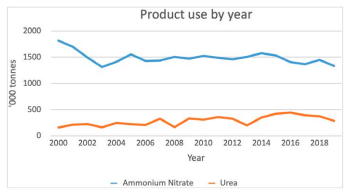
The Future Of Solid Urea Fertilisers Is On Trial.
James Warne from Soil First Farming defends urea and shows it may well be an easy scapegoat for the rise in atmospheric ammonia levels
It seems as though we are due to loose solid urea fertilisers very soon, or at least that is the conclusion I take from reading the current ‘Consultation on reducing ammonia emissions from solid urea fertilisers’. Out of the four options given, the stated preferred option is an outright ban on solid urea use. It appears the way forward has already been decided and this consultation is just an exercise. Does this meant that for those farmers using solid urea you will be forced to move to the only real alternative – ammonium nitrate (AN)? It seems to me that urea is being target not only as an easy victory but we are also chucking the baby out with the bath water. I suggest that urea brings some benefits over and above ammonium nitrate not only for the farmers but also in a wider environmental context over AN.
Ammonia emissions from agriculture fell by 21% between 1993 and 2013, but has risen subsequently by around 11%. Agriculture accounts for 87% of total ammonia emissions in the UK. Of this around 20% is attributable to inorganic fertilisers, the largest contributor of agricultural ammonia emissions are animal manures, particularly whilst in storage and spreading.
‘The British survey of fertiliser practice’ 2019 shows that total Nitrogen fertiliser use, averaged across grassland and cropping, is declining slowly and has been for several years. This seems to correlate to AIC data showing that fertiliser N consumption has been steady for the last decade at around 1030 kilotonnes (Kt) N per annum, which is well down on its peak of 1674 Kt N in 1987. While N use in cropping systems has remained steady, N fertiliser use on grassland has been slowly declining. If we analysis the data it is clear that since 2000 solid urea use in the UK has seen a significant rise (see the chart below) but has been dropping for the last few years. If urea were the cause of the increase in ammonia emissions within the last decade why were ammonia emissions decreasing in the first decade of the 21st century when there was a significant rise in urea use?

The UK has a legally binding commitment to reduce ammonia emissions to 8% below 2005 levels by 2020 and 16% below 2005 levels by 2030. Currently UK emissions stand just below the 2005 level, but projections indicate that the UK will overstep the 2020 target.
While there is little doubt that urea does contribute to net ammonia emissions its small fry compared to animal manures for instance, but it also brings some benefits too, not least where soil and plant health are considered. To understand this further let us take a closer look at the interaction of urea in the soil and plant.
Once urea hits the soil if there is moisture and biological activity, hydrolysis (breakdown of urea into ammonium and carbonate), controlled by the urease enzyme, will begin. This is where the main loss of ammonia gas can come from. Ammonium and ammonia will sit in equilibrium with each other, dependent upon the pH of the solution. See the chart below.
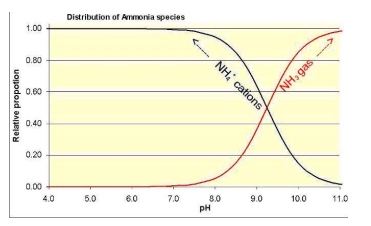
The amount of nitrogen lost as ammonia volatilisation depends upon a range of other factors such as, soil & air temperature, air movement, soil CEC, crop canopy and a wetting or drying soil. The biggest opportunity for loss is likely to come from spreading urea onto a drying high pH soil. In order to minimise this loss urea should not be spread onto damp high pH (>pH 7.0) soils unless significant rainfall is predicted soon after spreading. Application to bare soil in direct sunlight without incorporation can increase volatilisation significantly. Similarly application into a crop with a good canopy followed by rainfall will mitigate losses considerably. So if we are applying solid urea to crops with a reasonable canopy typically from mid-Feb through to mid-April what is the likelihood of their being the conditions for significant ammonia loss through volatilisation?
The urease enzyme which activates hydrolysis is freely available in the soil, around 30% of the soil microbiome produces urease. When urea fertilisers are combined with a urease inhibitor it is this reaction that is controlled which can be seem as worthwhile when taken in isolation. If however your desire is to build a biologically active soil, there is some conjecture as to how much damage these urease inhibitors may do to the soil microbiome.
Ammonium within the soil is then nitrified to nitrite and nitrate principally by Nitrosommonas and Nitrobacter bacteria. This is an aerobic process that will slow down considerably in the absence of oxygen and/or low soil pH. This process happens very quickly in soils which have excess air in them, e.g. cultivated soils, but more recent work has shown that where the soil is less disturbed more ammonium tends to exist. Plants can take up and utilise nitrogen as nitrate or ammonium. Ammonium being a positively charged cation can be adsorbed onto the cation exchange sites and it therefore less vulnerable to leaching and the crop can take it up selectively and utilise it more efficiently than nitrate. Nitrate on the other hand being negatively charged is very prone to leaching and whilst soluble in the soil solution is taken up uncontrollably as the plant respires.
The crop therefore has little control over the amount of nitrogen is it taking up. This is evident in the differing growth habits of similar crops grown on cultivated and non-cultivated soils. Those grown on cultivated soils tend towards nitrate nutrition and consequently are much darker green (almost blue) and lush. This tends to make the straw weaker and more vulnerable to lodging; more susceptible to disease, particularly mildew. Whilst crops grown on no-till situations tend towards more ammonium nutrition which gives them a shorter more prostrate growth habit and gentler, more natural green. The plant it is able to assimilate ammonium into proteins and amino acids with relative ease, while it has to convert nitrate to ammonium before it can be utilised, this ‘costs’ the plant energy approximately 16% more energy than utilising ammonium.
So we believe that urea can be an effective fertiliser if applied correctly that can offer advantages over AN in terms of soil and plant health together with similar or better environmental attributes such as lower energy requirement for manufacturing per unit N, less bulk requiring less transport and lower spreading costs, easier storage for the farmer. To name but a few. It’s also clear that urea came contribute to lower nitrous oxide emissions from the soil compared to AN. Research published from five grassland trials sites across the UK in 2019 shows that nitrous oxide (a potent greenhouse gas) emissions from grassland (and presumably cropland too) are higher when using ammonium nitrate and CAN as opposed to urea. Nitrous oxide emissions from urea use were further reduced by using a stabilised urea with DCD.
So where could the increase ammonia emission come from? We know that animal manures contribute the largest percentage of agricultural emissions, but sheep numbers have been steady, while cattle numbers have been in slow decline for a few years now in the UK. So what else could be contributing to the increase in ammonia emissions? Could it be that green energy production is a significant contributing factor? In 2013 there were less than 100 AD plants operating in the UK, that figure now stands at around 600 producing around 300 MWe. AD plants produce digestate. Approximately 18,000 m3 of digestate per MWe per annum. Or 5.5 million cubic metres of digestate total per annum. The available nitrogen within digestate is predominantly in the ammonium form. Some recent digestate analysis from a crop fed digester showed it had ~ 2.5kg ammonium (readily available N) per cubic metre. The current RB209 suggest that ‘around 40% of the readily available nitrogen content of organic materials can be lost following surface application’ but this can be reduced by 30-70% depending upon timing and form of application.
So if emissions from fertilisers only account for 20% of agricultural emissions, within that 20% urea only accounts for half, why is urea being targeted? Could it be that solid urea is the lowest hanging fruit?
-

Biology Up, Costs Down The Value Of Managing Soils
Let’s get straight to it and ask a simple question: ‘Is there a monetary return to be had from managing the biology of your soil?’

With every major agronomy company now having expanding soils programs and Government, post Brexit, replacing the common agricultural policy subsidises with payments in part based on environmental empathy, what is the strategy that underpins this? In the spirit of minimum tillage let us not dig too deeply into our current predicament in relation to soils. That said, it is worthy of reminding ourselves of some of the basic facts. Only a very small proportion of applied fertilisers is ever used by our crops. Our current farming practices in relation to rotation selection and chemical usage have acted to reduce the biodiversity of essential microbes in our soils; soil organic matter is reducing at an alarming rate; and we have a worryingly short period of time to reverse this trend.
Amidst the many scientific terms used to describe the complexity of soil science the one theme that is becoming ever more prominent is the concept of ‘plant efficiency’. Put simply it is a recognition that a plant, when it has an appropriate biological community of microbes at its roots, is better able to use both native and applied nutrition. This is a fundamental concept that once comprehended begins to lead our thinking about contemporary farming, for if a plant is more efficient it will be healthier, its systemic defence systems will be stronger, it will yield more and in relation to the soils, year on year things will get better.
All things considered and hopefully understood, what can we do as an industry to redress them? Well, the ‘long game’ in this story is being supported by the major soils programmes offered by agronomy companies that seek to offer to measure of current soil status on farms, and put plans in place to change practices and planting programmes to increase the biological function of soils.
So it could be argued, we have the terminology, we have direction, but what can we do this coming spring? Recent data from NIAB TAG research and other industrial sources on the use of biofertilisers shine light on the first real practical soil interventions for use by UK farmers. The UK has actually been working on the use of biofertilisers for many years. For the sake of clarity, we are not talking biostimulants, although they are often mentioned in the same breath, but rather biofertilisers comprised of living beneficial soil bacteria or fungi. Many companies are involved in this research and product development globally, leading this in the UK is PlantWorks Ltd, a spin out from a university some twenty years ago. Its science team have been refining soil bacteria and trialling them in UK soils for many years.
The company’s SMART ROTATIONS range includes both mycorrhizal fungi products and plant growth promoting rhizobacteria (PGPR) all produced at its production facilities at the Kent Science Park using controlled growing rooms and bioreactors. The company has spent years running laboratory trials to further understand the functioning of these beneficial organisms, both alone and in consortia, and have developed and tuned a number of products for use for crops grown in UK climate. Initially the company focussed on quantifying how its liquid bacteria products, sprayed to ground post emergence, could increase yield of crops by solubilising phosphorus, fixing and capturing nitrogen and making plants more efficient in up taking those nutrients. More recently, in collaboration with all major agronomy companies, and using its own monitor partner farms, it posed the question ‘with the biology of the soils increased how much applied nitrogen can be reduced in wheat production and what is the profit achieved?’.
For those not familiar with the SMART ROTATIONS SR3 products, they are a range of tuned consortia of beneficial soil bacteria selected and tested for their ability to fix nitrogen and solubilise phosphorous. PlantWorks supplies these bacteria in sterile infusion bags taking the bacteria directly from their controlled laboratory bioreactors. The company are at pains to point out that these are not compost ’teas’, but rather pure pharmaceutical grade bacteria grown in a very stringent conditions to an extremely high efficacy point, for those interested in such things the measure of potency is referred to as Colony Forming Units (CFUs). The products are supplied typically in 5 hectare units with 1 litre of biostimulant used as a feed source for the bacteria during establishment. SMART ROTATION SR3 liquid bacteria is applied to the crop post germination, for winter wheat planted in 2020 the ideal time to treat will be in early spring 2021 (GS25-GS31).
There has been a considerable body of work in the UK on the use of bacteria on wheat over recent years, both winter and spring, looking at the increment in yield alone without modulation of inputs. From a number of trials, across the UK using differing wheat varieties the average increase has been in the region of 6.0%, again attributed to improved plant efficiency. The results freshly in though are probably more resonant to a market where there is an increasing focus on farming for maximum profit, not yield and where there is an increasing sensitivity to the sympathetic management of the soil. These results are particularly interesting as the trends from three different sites are very similar. Studying the results on winter wheat KWS Zyatt the application of the beneficial bacteria shows an obvious direct effect on yield at the 100% nitrogen rate which is applied here at 260Kg/ha. Interestingly, as the nitrogen rate is reduced, the yield is actually maintained.

Comparing the percentage increase in yield to that the yield from the 100% nitrogen rate without bacteria application from two sites, one conventional and one regenerative, again, we see very strong correlation, which is statistically significant for those with a mathematical leaning.
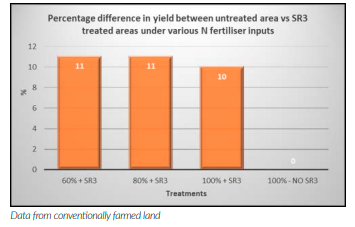
Data taken directly from the combine on both farms show a consistent increase in yield when the biology in the ground has been enhanced. In the conventional system the results range from between 10-11% increase with greater variation in the regenerative system albeit the average increase is very similar.

Taking into consideration the costs of the bacteria, typically at farm price of £20/ha and the extra spray run costs, reducing nitrogen inputs based on this data would achieve and incremental profit of £236/ha in the conventional system and £202/ha in the regenerative system, all whilst reducing the nitrogen loading on the soil. An independent trial undertaken by NIAB TAG designed by Dr Syed Shah, concurrently aimed to quantify the interaction of N-rate x SR3 (SMART ROTATIONS bacteria) on grain yield of winter wheat KWS Zyatt at its East Malling Kent facility.
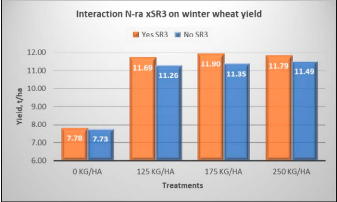
Here a negative control is shown with wheat planted without any nitrogen input and not unsurprisingly the yields are considerably lower than those where nitrogen is applied. The data in relation to yield at different nitrogen rates is though fundamental and may cause many to reflect on their standard assumption when it comes to nitrogen best practise. Very little difference is shown in relation to yield, and indeed on wheat protein levels, when nitrogen is reduced from the standard 250kg/ha to 125Kg/ha. In all cases, where bacteria are applied, there is a clear uplift in yield, at approximately 5%.
Globally the market for bio fertilisers is reported to now exceed $1 billion a year. Not unsurprisingly industry is returning again to look at the natural biology in soils as a source of new products with the goal of enhancing ‘plant efficiency’.
-

Soil Cultivations: Ploughing, Non-Inversion Tillage And Soil Quality
Ploughing has received bad press in some organic farming circles due to the higher fuel requirements and the fact that it buries soil organisms and green material at too great a depth. The perennial questions are: should we plough and if so how deep?
Written by Mark Measures, Agricology Group Steering Member

Over many years I have remained a supporter of the plough but been actively involved in non-inversion tillage organic farming trials; the focus on minimising damage to soil life such as earthworms and mycorrhizae, avoiding disruption of the optimum stratification and depth of soil organisms, avoiding turning down manure, green manure, and the fertile topsoil too deep for maximising plant utilisation, all make shallow ploughing and / or minimal tillage a no-brainer. But it is not as straightforward as you might think! And don’t be taken in by the over-enthusiastic specialists who extrapolate successful practice in their own situation to universally applied dictates and dogma; site specific solutions are generally needed, even if we are working to common principles underlying a more sustainable farming.
Many farmers have discovered that they can do without the plough; experiences are reported in the IOTA Technical Leaflet Non Inversion Tillage in Organic Arable Cropping. This review features Richard Gantlett who has shown that with a combination of tined and duck foot cultivators, generally used in multiple passes it is practicable to operate a non-inversion tillage system on the well drained, relatively easily worked, calcareous clay loam soils of Wiltshire. This avoids inversion but still involves working at 15 – 25 cms.
More radical is the work of Friedrich Wenz of southern Germany who has developed a stockless farming system based on a unique machine, the EcoDyn. This fixed tine tool bar allows very shallow cultivations and weed control by repeated skimming of annual and perennial weeds. While in some circumstances good results have been achieved, weed control has not been as good as with a plough and where multiple passes have been made in order to get better weed control crop yields have been substantially reduced due to poorer soil structure and aeration in winter crops on heavier clay loam soils in Gloucestershire. The results from our work at The Organic Research Centre are interesting. Perhaps Wenz also found that the fixed tine, tool bar technique does not always work as well as he claimed as I see that he is now also using powered cultivators.
Direct drilling cereals into a crimped green manure is currently much in vogue, enthusiastically advocated by the Rodale Institute in Pennsylvania. They make great claims for carbon sequestration using this technique; in my experience they are unlikely to be achieved in all soil and environmental conditions. Unfortunately the research is not fully written up. The technique has not proved consistently effective in the maritime climate of the UK or in the Argentine Pampas, where I am involved. It remains one of those good ideas which has a long way to go before commercial application in the UK.
I have been motivated to put these notes together by the very recent publication of results from the long term DOC trial at FiBL in Switzerland, which includes a 15-year comparison of ploughing with reduced tillage. Read the report for the full details but among key conclusions they found: “Clay loam in temperate Switzerland: reduced tillage vs. ploughing, solid vs. liquid manures and biodynamic preparations. A synthesis of 15 years reveals an increase in topsoil organic carbon (SOC, +25%), microbial biomass (+32%) and activity (+34%) and a shift in microbial communities with conversion from ploughing to reduced tillage. Soils under reduced tillage are more stratified in SOC and nutrients……………Both higher and lower yields were harvested in the reduced tillage system in relation to ploughing. The main yield determinants were N supply and higher weed infestation under reduced tillage. Continuously reduced tillage in organic farming has been proven to enhance soil quality at this site, while also presenting more challenges in management.”
In this trial there are some clear advantages for the reduced tillage system over ploughing, which are in part due to shallower cultivations (5 cm – with occasional loosening to 15 cm – compared to ploughing to 25 cm) avoidance of inversion, and less soil disturbance at depth. This trial shows some very significant advantages for many beneficial soil organisms including earthworms and fungi. Not surprisingly the trial found soil carbon was higher in the top 10 cm layer with reduced tillage. However, unlike many other cultivation trials results, which show lower soil carbon below 10 cm, in this trial soil carbon was similar in both systems, probably due to the soil type.
Lessons learnt

Ploughing is not all bad and it remains the most effective means of weed control, it is usually essential for crops such as potatoes and it is a predictable method of seed bed creation, particularly in difficult weather conditions. So ploughing is likely to remain an option for many if not most organic farmers, just ensure that you have the right plough bodies to allow you to plough as shallow as possible.
Look at all the relevant research, observe and learn from other farmers and advisers, and develop a system and practices that are appropriate to the soil and environmental conditions in which you are working.

-

Drill Manufacturers In Focus…
STRIP TILLAGE BEST PRACTICE

What a year it has been.
Now that we are nearing the end of this unforgettable year it is a good chance to look back and reflect on what a year it has been and just how encouraging it has been for us growing the Virkar Brand in the UK. The Virkar brand is rapidly growing here in the UK and coming off the back off a highly successful autumn demonstrations programme where we had to deal with some particularly challenging autumn weather. 2021 looks to be even better. With more drills working on farms across the country, new Virkar products being launched, and the continued growth of Virkar in the UK. Next year looks to be very encouraging for us.
2021 Changes to the Virkar Dynamic DC
Having our own test farms allows us to constantly evaluate the drills performance and strive to always develop it further. Having our own farms means we can relate to our customers and understand exactly what they need in a machine. Knowing our product like we do and using it on our own farms gives our customers confidence in the machines and peace of mind that we will always be there to offer support.
One of the changes has been the cooperation along with JJ Metcalfe to now be able to run their low disturbance seeding point on the Virkar Dynamic DC drill. Having run and evaluated this point on our demo drill this autumn it has performed incredibly well and moving forward it will now be an option to choose between the standard Virkar point or the JJ Metcalfe point.
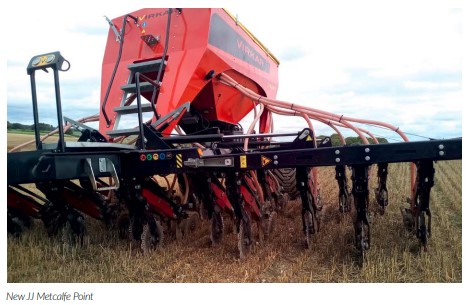
Other changes to the Dynamic DC for 2021 is a new inhouse built Virkar ECU for the drills electronic control of all major function, which has greatly reduced the amount of cabling on the machine. Combined with other updates that include the main hydraulic lines being upgraded to improve the machines longevity and general performance. The ethos of the Virkar Dynamic DC is to maximise performance and crop establishment, combined with low operational costs. Having machines including our own carrying out operations on some very stoney clay capped ground has allowed us to really get a sense of true running cost in terms of wearing parts.
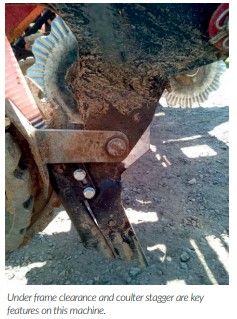
Something else we are working on is the ability to use the drill as an inter row hoe. The factory is currently evaluating several point options and we are hoping to carry out field trials in the Spring. We are seeing a big increase in interest for inter row hoes as farmers are looking for ways to reduce their reliance on herbicides. With the way the Virkar Dynamic DC works and the coulter design with contour following and on the move pressure control as well as the steering rear axle which ensures the machine is always running true behind the tractor, makes the drill a good starting point to try inter row hoeing in a direct drilling system. If testing goes well in the Spring then this feature enhances the drill even further to set it apart from the competition.
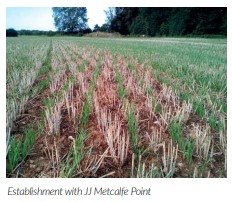
Wider Dynamic DC Drills coming 2021
Virkar have been working on and will be out testing in early 2021 a nine meter model of the Dynamic DC. The plan is that this new range of wider drills will be on a completely different chassis design and eventually they will be able to offer widths from 9-13.5 meters in this configuration. Like everything Virkar do their philosophy is to build the highest quality machines. Virkar wishes to listen to farmers and at the same time provide a modern and technological outlook, thanks to its multidisciplinary team, to create high quality and reliable machines whilst keeping them easy to operate with a high degree of innovation.
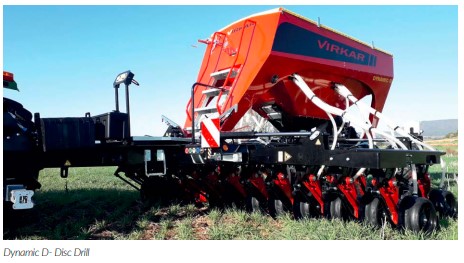
New for 2021 is the direct disc coulter version of the drill. The Dynamic D has been thoroughly tested in tough Spanish conditions for 2 years. The coulter design means it can mount into the same frame as the Dynamic DC drill meaning you keep the modular design with all the benefits this provides, widths from 4.5-7 meters will be available with 19 or 25cm row spacings.
The coulter arms are maintenance free, they have sealed bearings and bushed everywhere there is a pin. The coulter design means you get 35cm of travel for contour following, with on the move coulter pressure adjustment, and only one manual adjustment per coulter leading to quick set up time in the field. Again, the drill can be specified with 3 hoppers and various other options.
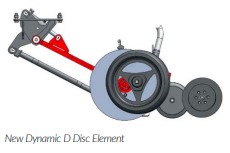
We already have a lot of interest in the Dynamic D mainly due to its contour following capabilities, and the simplicity and ease of use. This machine now allows us to offer both methods for direct drills, which Is only going to help us moving forward into 2021 growing the Virkar brand further. The plan for us is to have one on show at the Groundswell event in June as well as running a demonstration unit in the Spring to run alongside our demonstration Virkar Dynamic DC. This December marks two years since we first came across the Virkar brand. Who knew from watching a video of the drill online we would now have numerous drills running across the country, a demonstration book already nearly full for the Spring and that is before we have got our hands on the new Dynamic D drill to showcase to farmers/contractors.
It is clear to see that the Virkar brand will go from strength to strength in the coming years, and 2021 is very much looking to be busy, but we would not have it any other way.
-
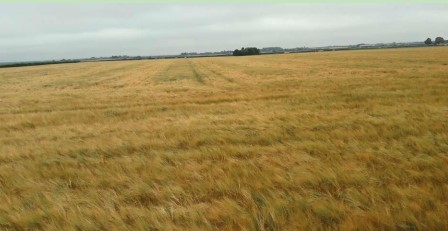
It’s In Our Nature…
James Warne from Soil First Farming defends urea and shows it may well be an easy scapegoat for the rise in
atmospheric ammonia levelsWhen I have something on my mind I tend to reach for a cup of tea and a biscuit. Those who have seen me will be able to verify this happens often. This is exactly where I had gravitated to one wet Saturday morning two years ago after paying another round of chemical and contracting bills and it was apparent there was going to be very little margin even if we did have a good year. I sat at the table and opened the country section of certain Yorkshire paper. There was the article penned by Angus Gowthorpe in which he spoke of his farming method “conservation agriculture” and his association to BASEUK. That article has led to a great many things for me.
I originated from a small livestock farm near York and have found myself on an Arable farm in East Yorkshire. I have no previous experience of Arable land management, cultivation or cropping. A recipe for disaster if there ever was one. Possibly it is a blessing as I have no preconception of how things should be done, and ignorance is bliss. The ethos of what Angus had written resonated with me, so I applied for my BASE membership and embarked on my voyage of discovery.
A few farm visits ensued to people who were practicing regenerative agriculture methods, and these were a real insight into what they were encountering. How the principle adopted translated into the practical. Mostly I loitered at the back hoping not to trip myself up by saying something stupid but absorbing as much information as possible. Everyone was very welcoming, and I felt confident to attend my first BASE AGM.
Two days of guest speakers. I will admit it was with some trepidation that I took my seat on the first morning not knowing anyone or what to expect. Those two days were like a light bulb moment! I learnt about soil, soil health, physical, chemical, and biological indicators. Financial costings, worm science and so much more. The whole event was recorded for members who could not attend to access later. I returned to the farm with enthusiasm. Previously the only time I might have got close to making holes in the ground or sniffing soil was if I had fallen off a horse. Now here I was with my shovel counting worms, really looking at the soil, what the structure was like, getting soil samples, doing filtration tests. I had begun to ask questions and look for the answers. The photograph above shows our first attempt at direct drilling…. Spring Malting Barley.

It was very clean all year although drilled nearly 3 weeks later than the more conventionally established only yielded slightly less. The lower chemical and cultivation cost made up for any yield deficit.
The first time I asked my contractor to put a molasses like substance through his expensive sprayer with the liquid fertiliser there was a raised eyebrow. To his credit he went along with it. I am not completely sure who was the most relieved when it all went without a hitch. I may not know a lot but have been incredibly blessed to have a fantastic agronomist and great contractors supporting me throughout. From the AGM I learnt about Groundswell and that is where I headed next. BASE has opened the door to a great many things. Recommended reading lists have provided a wealth of information, Farming Forum, Agroecology, and pod casts.
This year’s AGM was held at York pre pandemic. Speakers included Dr Sam Cook from Rothamsted Research, Dr Lea Harold from the PGRO, Edward Dickin on plant breeding, BASE-UK Member farmers, and scientists but for me Dr Anna Krzywoszynska was a standout. She spoke of “geosmin”; a chemical released from dead microbes in soil and how the human body can detect this smell in minuscule quantities, an evolutionary hangover that has the ability to lowers the heart rate – amazing! We need to trust our instinct. She spoke of the communities of practice, how we learn, seeking information, motivation, experimenting and how psychologically hard it is to make a change on your own. BASE has given me that community of support.
Especially welcome through the COVID-19 pandemic BASE has held webinar meetings, again, all recorded with BASIS and NRoSo points available. The quality of speakers throughout has been inspiring, diverse and educational. From mob grazing systems to the Lamport research trials to Fredric Thomas to name a few. BASE manages to cater for the novice like me to the very experienced.

The photograph above is of some of the expanding sheep flock as we start to get some livestock incorporated into the arable system.
The pandemic has highlighted how important conversation and a sense of belonging are. Normally I would play badminton, go swimming, attend a competition with the horse or head off to the livestock market and all that social interaction has gone or is seriously restricted. The Zoom meetings have been fab and best of all, if I look a bit of a mess, I can keep my camera off.
I have had many a night in the last two years laid awake worrying about if I could manage the task ahead of me. Was I making the right decisions? Will the cost of cover cropping be worth it? The intake of breath through gritted teeth from people who have farmed this type of land when they hear of my next step. It does really make you doubt if this moral path is right, after all “the road to hell is paved with good intentions” they say. No doubt there will be some failures along the way. From John Wooden the quote, “Failure is not fatal but failure to change might be”.
Male, female, young or old, the demographic is irrelevant. If you have an enquiring mind, then BASE-UK membership has something to offer you even if it is just to have a support network of likeminded people working towards a common goal to make agriculture more sustainable for future generations.

-
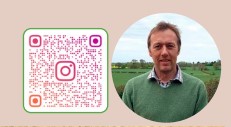
Farmer Focus – Neil White

Harvest now seems like a distant memory; thank goodness you say! We seemed to get away reasonably light here in S.E. Scotland compared to many others around the UK. I still run two systems on some crops, and I can compare the results rather than wonder what if?
It started with the poorest crop this year, winter barley. The direct drilled and plough/ combi drilled crops were equally poor, at best 2/3 of an average crop but easy to cut and dry. I have struggled to get my strip tilled winter barley to match my plough/combi yield and although close this year it was again below. It was obviously much cheaper to establish but I think the fact my winter barley is at the end of my rotation may be causing a delay in the improvements shown by the other crops.
My Mzuri sown Diablo spring barley matched my plough combi drilled yield this year and that was all above my 5-year average. The TGW of the barley was greater on the Mzuri sown ground, which was as I had hoped, the wider rows allowing light inception and a fuller grain. The Mzuri sown Canyon spring oats, for Quaker out yielded my plough/Combi drilled oats by over 1t/Ha and cost 1/4 of the establishment cost. The oats sown after the plough struggled in the dry spring (as I show on YouTube) and never caught up. The wheat was all sown with the Mzuri and like most in the area was very bold but mostly below average. The spring beans sown directly into overwintered stubble were the highlight at the end of my harvest, they yielded well above average and were a first-class sample. The beans went in well and the lack of soil disturbance retained the moisture, that gave them the great start shown on YouTube and Instagram as I love walking in them.
I continue to look for answers regarding the winter barley and there is a lot of advice out there. As well as reading this magazine, I follow lots people and businesses on Instagram and online. The Soil_doctor is one which provides lots of information which stimulates thought, although not always easy to apply in my situation. They recently had a periodic table of cover crops which was very cleverly laid out and worth a look. My version of cover cropping this year also incorporates my favourite form of muck spreading, it is on around half my spring oat stubble which will be over-wintered, spread with calcium lime and then drilled with Diablo spring barley. The stubble had a good cover of volunteer oats growing in it and a small flush of weeds which developed late due to the dry spring.

I called a neighbour whose sheep graze my TGRS, he provided another batch which have now had a month on the stubble tidying it up and adding some manure without the compaction. The benefit of the grazing and muck may be minimal, but the lack of traffic involved can only be a good thing for my soils.
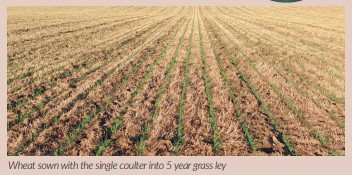
According to a recent BBC news article England uses only 0.41% of its environmental monitoring budget monitoring soils! This seems mind blowing considering we know how important a healthy soil is and as farmers we have been testing soils for a considerable time now realising what we do has a big influence on them.
Scoring your soil using VESS scoring system is something SAC promote and while I am not necessarily using this system I do frequently walk, dig and examine the soil as this is a simple guide to its condition. Trust your eyes and nose, I read recently that we have in our DNA the ability to recognise healthy soil by its smell, this check is cost free. In September, having held off last year due to the wet conditions, I spread the ash from my biomass boiler on some of the less favourable heavy clay patches in some fields. While this is a very blunt instrument this has helped soil condition and achieve more tilth and a more even crop emergence.
I am using Solvita burst soil testing and while the results were relatively good to start with, I have noticed a great improvement in my soils in the relatively short time I have been direct drilling/strip tilling. The structure of the soil has visually improved in this time and I am now beginning to re-test some of the fields direct drilled from the start in 2015, they have been ploughed 1 or less times since then. I know that true direct drillers would maybe say my approach, still using a plough in rotation, is a bit like claiming your a vegan and having meat once a month but I can’t yet remove the plough completely from my rotation. The shame of it!!
Some of the soil damage is being caused by harvest machinery. I have written before about trying to look at cause rather than mechanical cure. This has been a costly exercise for me, my combine was overdue a change so putting my money when my mouth is I ticked the track and the power spreader options, two things I feel can play a big part in improving my soils. The tracks will reduce the compaction caused in the less than ideal conditions we, in Scotland, are often forced to cut in. This will allow me to raise the leading leg on my drill, and the spreader is a must as a good spread of chopped straw is essential for my system.
Establishment of winter crops this year has been good with challenges similar, but much less extreme, compared to last years. Early sown crops have fared the best with record high rainfall in October compromising some later crops and calling an end to some farmers autumn campaign. Where we are in SE Scotland once the weather and soils turn wet, they can often stay wet until spring. I drilled wheat for a neighbour in October this year. A 5-year grass ley, sprayed off, then wheat sown directly with the single coulter. This was the first time I had done this and despite the front leg running around 6 inches deep the single coulter left a narrow almost minimum disturbance finish, and the crop has emerged well.
I have tried some companion cropping this year in my OSR. We do not have the severity of flea beetle problems experienced farther south but like a few farmers in this area I thought I would try some companion crops so I had experience of what may work up here. I have tried a block of Buckwheat and a block of Berseem clover in my OSR, each mixed with the slug pellets and spread out the pelleter on the drill at sowing. I was putting fertiliser down the leading leg on the drill, OSR seed at the coulter then pellets and companion crop down at the harrow rather than mixing the companion with the seed in case it settled in the hopper. The buckwheat has established well whereas the clover has not.
The suspicion is that the preem which was deemed ok for clover may have found its way to the seed and killed it off. My conclusion from the trial so far is, if your growing Buckwheat put in a sacrificial crop of OSR as buckwheat seems to grow well but the predator here is more often slugs which still prefer to eat OSR. It is good to know the buckwheat established well with this method and now the frost has killed it off maybe it will leave some fixed nitrogen, providing a benefit and an option for the future. Maybe something which slugs prefer to OSR would be a better companion!? I will have another go next year. I have mixed wheat varieties again this year in some fields, mixing seed in the drill, then treating the whole field as the lower input variety. I find this works well.

I know I am not as brave as many other contributors to this magazine, I do have very low establishment costs and I am beginning to reduce fungicides and insecticides on my farm, and as my soils improve I hope I can go further each year.
-

Sharing The Strategic Farm Results
Teresa Meadows, AHDB Knowledge Exchange Manager, East Anglia, takes a look through the season and findings from the Strategic Cereal Farm East and West demonstrations for harvest 2020.

As we come into the autumn time, it gives an opportunity to look back on the last harvest – yields, costs, margins and wider improvements to soils or biodiversity achieved over the previous year. Whilst harvest 2020 will be a year to forget in so many ways, there are always lessons that can be learnt along the way. Reflecting on the last season of results from our AHDB Strategic Cereal Farms in the East and the West, this is certainly the case for them too.
The difficult conditions in autumn 2019 and spring 2020 meant that establishing a crop was a real challenge for Rob Fox, Strategic Farm West host in Warwickshire. With much of the OSR area needing to be re-drilled and wheat not able to be drilled at all, alternative solutions were sought to take advantage of the situation. This included the establishment of a summer catch crop area to look at the advantage of having cover in place vs the stubble for the following crop establishment, nutrient uptake and more.
Over in the East, Brian Barker, the farm host in Suffolk had patchy establishment in some areas, challenges to spray off cover crops with enough time to drill the following crop and making decisions on what to do with the opportunity to lower inputs in what resulted in a largely low disease pressure year.

The results from the findings of these trials and demonstrations and other longer running demonstrations on-farm, can be found summarised below. Full details including the reports, graphs and costs are available to download from the links at: https://ahdb.org.uk/sfweekwinter-2020.
STRATEGIC CEREAL FARM EAST
How to manage lowering fungicide, trace element and biostimulant inputs and harnessing varietal resistance
This trial has been looking at how to use varietal resistance as a way of reducing fungicide inputs. Five varieties were assessed (Siskin, Crispin, Santiago, Graham and Shabras) and four programmes of increasing cost were overlaid (untreated, low, medium and high). As harvest 2020 was a low disease pressure season, the results showed that growing more resistant varieties with a low input regime gave the best net margin in this year.
There was a minimal yield response to increasing fungicide spend on the resistant varieties with the low inputs, showing the best net margins. In this year, the highest percentage of septoria was seen on the most susceptible variety, Santiago. The more resistant varieties (i.e. Graham and Siskin) tended to hold onto green leaf area for longer. Varying programmes according to the season, looking at, knowing and harnessing the varietal resistance can certainly work in this kind of season.
Boosting early crop biomass
This demonstration has been looking at whether using a starter fertiliser, either placed or broadcast, is effective at boosting biomass in the autumn. Establishing crops later in the autumn, due to black-grass and BYDV pressure is balanced with the knowledge that crops that yield well have good biomass from the autumn. This demonstration was looking at if it was possible to boost this further with later-drilled autumn crops. The results from this year showed that there may be yield benefits from broadcasting kieserite and possibly TSP at planting where soil nutrient indices are low. However, established plant populations in both fields were fairly low and crop development was slow over winter, due to the season.
On one of the fields, broadcast kieserite and TSP appeared to increase yield by up to 0.4t\ha, whilst polysulphate showed no yield benefit compared to standard farm practice. The results from this work haven’t drawn large conclusions in terms of final yield results, but will be something to bear in mind as we go forward about using this option at drilling.
Cover crops and water quality
Cover crops are well known to have a positive effect on water quality and soil structure. The results from this trial have reinforced those conclusions, demonstrating that a well-established cover crop is effective at improving water quality by bringing nitrate concentrations in drainage water below 50 mg/l. Four different methods have been looked at this year, the second site that we have used the same principles – an area that was ploughed; an area that was ploughed and then a cover crop (rye, buckwheat, phacelia, oil radish, sunflowers) established; an area that was overwinter stubble and then an area of over-winter stubble with a cover crop drilled using a strip till drill at 33cm row spacings.
Soil structural assessments (completed on 14.02.20) using Visual Evaluation of Soil Structure (VESS) scores also indicated that the soil on the ploughed field, Appletree, was classed as being ‘firm’ with some angular non-porous aggregates (i.e. clods) present; whereas in the one-pass system on Blacksmiths, the soil structure was better (i.e. friable/intact) containing more porous aggregates and no clods. Bulk density within the cover crop-ploughed area was marginally higher at 1.57 g/cm3 compared to no cover crop-plough suggesting the soil was more compact which could have impeded root growth.
A good number of earthworms were also recorded across both of the trial fields (i.e. more than 8 per pit), mainly comprising juvenile and adult endogeic (topsoil) earthworms. Overall number of earthworms were greater on Blacksmiths, which was cultivated using a strip-tillage one-pass system (mean = 20) compared to Appletree which was ploughed (mean = 11), with no difference between areas with or without cover crops. Epigeic, (i.e. surface/ litter dwelling) earthworms were recorded on Blacksmiths but not Appletree fields; this corresponded to there being more surface trash following the one-pass system, compared to ploughed. The overall greater number of earthworms and presence of epigeic earthworms on Blacksmiths compared to Appletree, indicates that ploughing maybe having a detrimental impact on both overall earthworm numbers and community structure by reducing the availability of surface trash and disturbing burrows.
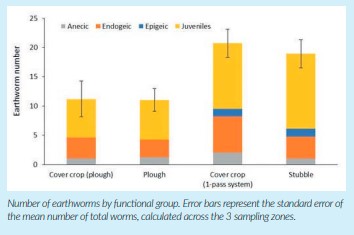
On both fields, the mean yield measured within the cover crop area was c.1.7 – 2 t/ha lower (95% confidence interval = ± 0.24 t/ha) than the ploughed treatment at 8.1 – 8.3 t/ha. Drilling the cover crop after autumn ploughing, caused some surface soil compaction and Brian Barker noted that it was harder to drill the spring crop; the slots did not close and pigeons ate the seed. The cover crop area on the one pass system also led to wetter soil conditions at spring crop drilling, with more slug damage. Throughout the season, on the cover crop treatment the spring crop was consistently ‘behind’ compared to the overwinter stubble treatment.
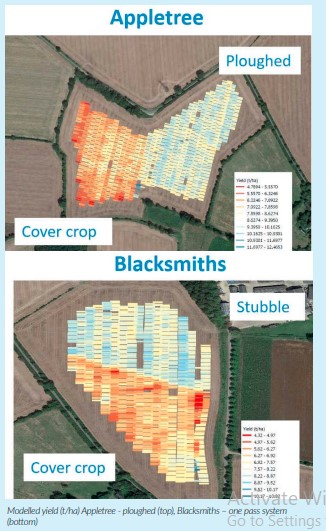
This final result was different to the result from harvest 2019, which showed a positive yield effect after the cover cropped area. This variation in yield (both positive and negative effects) has also been noted in the AHDB MaxiCover Crop research and wider research. It is learning this balance between the original aims for using cover cropping on-farm, which species to use, how to manage their establishment and destruction and release of the nutrients through the following crop that are questions to still be discussed and shared.
Conclusions from this work do continue to show the many benefits of cover cropping to water quality and soils. Furthermore, in the spring if wet soil conditions are likely, allow soils to dry out by leaving a large enough ‘window’ between cover crop destruction and spring crop drilling.
Very low inputs – how low can you go?
A 3.1ha field was also used at the Strategic Farm East this year, where Brian went as low as he felt that he could go with inputs through the season. During the harvest 2020 season, this resulted in a total fungicide spend of £12/ha, a yield of 9.43t/ha and a cost of production of £67/t. Given the low disease pressure season of harvest 2020, these results suggest that there is little benefit in increasing fungicide spend to improve gross margins. Do we have the evidence, in-season monitoring and forecasting and information available to do this at scale going forwards?
STRATEGIC CEREAL FARM WEST
The impact of cultivation depth on soil properties, rooting and yield
The aim of this trial is to determine any differences in soil quality and health, crop rooting properties, yield and cost of production between cultivation systems. Starting in 2018, with three cultivation depths at 5, 15 and 30 cm depths before the addition of direct drilling in 2019, this trial will continue for the duration of the Strategic Cereal Farm West programme. OSR was established in this trial field for harvest 2020 and the results showed the importance of moisture at drilling for OSR. Minimal cultivations and direct drilling can both help to maintain moisture levels for better OSR establishment. Crops that are establishing slowly are at risk from CSFB attack.
As a result, poor plant establishment and fewer plants were found in the deeper cultivation treatments (15 and 30cm) than the shallow cultivation (5 cm) and direct drill treatments. In general, more CSFB adult feeding damage (as % leaf loss area) was found in the treatments with deeper cultivations (15 and 30cm cultivations) than the 5 cm cultivation of direct drill treatment. Additionally, fewer larvae were found on the deeper cultivation treatments (15 and 30cm) compared to the shallow cultivation (5cm) and direct drill treatments, in both November and January (P<0.05).
The average measured yield for harvest 2020 for the 30cm treatment was 2.22 t/ha with yield differences for the treatments showing: 15cm: -0.09 ± 0.51 t/ha 5cm: -0.70 ± 0.50 t/ha Direct drill: -0.53 ± 0.58 t/ha.
The impact of summer catch crops on soil physical properties and performance of the following crop
This demonstration, which started in 2020, is looking at the effect of a summer catch crop on soil nitrogen supply, soil structure and the performance of the following crop in the rotation. In this trial we are comparing the impact of comparing summer catch crop mixes to leaving the land fallow. Three treatments were established in May 2020; a control where the field has been left in stubble, a phacelia and oil radish mix, and farm saved seed and barley. The catch crop was assessed in July 2020 and the results showed:
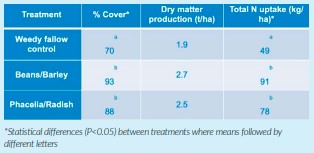
The topsoil was also noted to be slightly drier where the catch crop treatments had been grown and the soil N supply higher where catch crops were grown. Soil and crop characteristics across these three treatments will now be assessed through to harvest 2022.
So, lots of questions asked, assessments taken place and conclusions that can be drawn across some areas…and always more questions to ask as a result! As with much of what we do in farming, the best place to learn and find what suits your system is to try this out on-farm. The aspiration is that the demonstrations on the Strategic Farms put into practice the findings from the research and then the resources are created for you to be able to take this forward for your farm or business. This can be from counting plants at establishment, disease scoring your crops through the season, looking at earthworm levels or calculating the costs. The links to all of these resources are all available from: h t t p s : // a h d b . org.uk/sfweekwinter-2020.
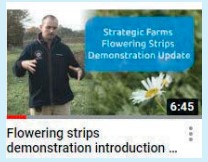
Many of these results were also discussed through webinars held on these topics, along with wider areas such as weed management and boosting beneficials through the use of flowering strips, through the Strategic Farm Week held on 16-20 November. Recordings of these, along with other videos can be found via the same link above or on the AHDB Cereals and Oilseeds channel on YouTube. As we turn now to harvest 2021, some of the themes of cover cropping, weed management, cultivations, pest and natural enemy assessments are being taken forward, along with new areas of work. We look forward to sharing these results as we go through the season.
As ever if you have questions, comments, suggestions or would like more information, please feel free to get in touch.
-
Bring Back The Cow!
Written by Tom Chapman – Mob Grazing Specialist at EnviRumen Ltd
The value that grazing ruminants bring to soil is, once again, starting to be appreciated by farmers. The combination of their dung, urine, saliva and hoof action, plus the effect of the forage plants, all help to bring dramatic and welcome improvements in soil health.
The true benefits of cattle were highlighted to me when I visited Jay Fuhrer at Menoken Farms in North Dakota several years ago. He spelled out the five key practices for soil health. The first four were: Keep the soil covered; keep a living root in the ground at all times; do not disrupt the soil, chemically or physically; and have lots of diversity, avoiding monocultures. When he came to the fifth, his eyes lit up: Bring cattle into the rotation. He became excited, animated as he spoke. He grabbed his spade and started digging into the strange, grey-coloured sand at Menoken. He grabbed two sods from different patches, triumphantly pointing out that one was much darker, much more enriched with carbon, than the other. “Three years!”, he exclaimed, “Only three years and we can already see a marked difference”
It was true, the cattle had been moved onto the arable fields only three years earlier, as part of a changed rotation and the differences were both stark and encouraging. It gives hope that we can restore our soils in a relatively short time, through careful and considered management practices which include all of those five principles Jay outlined to me back then.
Ways to get livestock on arable farms
The challenge is how we do it? How does the average arable farmer get into the livestock game when he or she may have no interest, no skills, no infrastructure, no capital and no support? What does it take to bring cattle back on to your farm? If you are seriously considering reintroducing cattle or sheep, now is the time to start planning. The things you need to consider are:
• What type of livestock would you prefer?
• Who will own and manage the livestock? If a 3rd party is involved, then: o What terms of tenure will the land be occupied under or would you prefer to enter into a partnership or joint venture? o What fencing will be needed and who will be responsible for erecting and maintaining it?
• How will the livestock be watered?
• Will the livestock be there all year round and, if so, what are the winter plans?
• What forage crops will be grown?
• What are the income and cost implications of bringing back livestock?
• What is your end goal regarding soil health and the regeneration of your land?
There isn’t space in this article to look at all the options and different permutations, so I will just touch on the main alternatives available to you.
Most people think of either cattle or sheep, but don’t forget poultry and pigs as alternatives that could help improve your soils. Ideally you would find a way of combining two or more species, as the soil health rule of avoiding monocultures applies as much to livestock as it does to crops. Cattle and chickens work especially well together, with the latter spreading the cattle dung and eating a lot of the fly larvae, if they follow on behind the cattle in a mobile chicken run.
When it comes to ownership and management, there are a lot of alternatives. Simplest is some form of rental: Let the land to a neighbouring farmer on a licence agreement and he is responsible for erecting temporary fencing and grazing the land. Tack sheep is a good example of this in practice, used widely in the UK. Cattle can be slightly harder to control with temporary fencing though, with trained animals and a decent energiser (to power the electric fence), I and a number of farmers are doing just this.
It may be that you decide to enter into a partnership, share-farming agreement or joint venture with a livestock farmer. This can be a great way to give a young farmer a helping hand up the farming ladder. Often such people have bags of enthusiasm, a desire to work hard for long hours but a lack of access to land and capital. Or you may have a neighbour or nearby farmer who would benefit from the opportunity to expand too. If anyone is in the Hertfordshire / Bedfordshire area and would like to discuss this, I am always keen to expand my cattle operations and will be happy to meet with you to talk it through. If you’re further afield then I also provide a consultancy service, to guide you through the different options and pitfalls!
Fencing and forage
Moving back to things you will need to consider, a properly fenced field, with running water should command a better rent than an unfenced block of land. However, many arable farmers won’t be able to justify the investment when the forage crop is only going to be in the ground for, typically, four or five years. You may prefer the tenant to sort out the fencing. I often use high tensile wire, insulators and removable fence posts as a semi-permanent barrier around the perimeter of a block of land. As already mentioned, if cattle are trained and you have a good (preferably mains) energiser, and you manage the grazing correctly, cattle are very unlikely to escape from such a set-up. The beauty of this is that, with a little work, everything is removable and reusable so, although the initial costs are high, I can spread this over many years and several blocks of land.
A potentially more difficult issue to solve, on many arable farms, is that of providing water. Cattle in particular can drink large quantities every day, especially in hot weather, and some form of pressurised supply – mains or pumped – is preferable to a bowser, though the latter can suffice. There are some decent solar pumping systems on the market nowadays too, which will pump water for considerable distances (as well as powering an electric fence energiser), if you have a river or open water source nearby.
Not all livestock need to be housed during winter, especially on lighterland farms. If you get the stocking rate right and manage the grazing carefully (typically under a mob grazing regime) then it is possible to keep both cattle and sheep outside all year round. However, there is a significant amount of skill required for this and I would always recommend it is undertaken by people with good experience of managing cattle under such systems. I have kept cattle outside all year round for the past six years, including through the “Beast from the East” and have found they are actually healthier, overall, when outside than when they are indoors.
To get the most from the system, a good diversity of forage crops should be grown. This is your opportunity to have deep-rooting perennial plants bringing minerals and nutrients up from deep into the soil profile. These deep roots will also add valuable organic matter to your soil and should help with reducing and removing blackgrass from your fields. However, you should consider a couple of things, particularly whether any of the chosen species could act as a disease bridge for the following arable crops (unlikely) and how easy they will be to terminate at the end of the forage period of the rotation, especially if they have set seed in the interim.
Figuring the finances
When it comes to the financial implication, there are easy calculations and much more complex ones! It is simple to calculate the cost of the seed and establishment, the cost of the crop income foregone and the cost of water and fencing, and to match it against rental income or from livestock sales. There will also be savings in future years compared to cropping it, as you don’t have to incur establishment costs annually.
Less quantifiable is the long-term value of having livestock on the holding. We know the benefits – your organicmatter-rich soils will hold more water so yields in a dry year will be better; your soils will be more fertile so will need less artificial fertiliser; a forage break should see a decrease in annual weeds such as blackgrass which will lead to savings in herbicides; crops are healthier following livestock so fungicide costs fall. These are all benefits we see through the reintroduction of grazing herbivores, but quantifying it and building it into a budget is difficult. It does need a leap of faith, though I have yet to speak to a farmer who has brought back cattle and sheep who has any regrets on this score.
Getting the right end goal
Tied into this is my last bullet point, above, namely what is your end goal regarding soil health and the regeneration of your land? If you have reached the point where you are seriously considering bringing livestock back onto your land then you are likely to be well down the road of regenerative farming. A friend summed it up to me a while ago when he said conventional farming is all about killing things (weeds, pests, fungal diseases) and is a constant, and ultimately fruitless endeavour. However, regenerative farming is all about helping things to survive, working hand-in-hand with nature, rather than battling it. I understand why Jay Fuhrer’s eyes lit up when he spoke about the power of the cow and the health of his soil. It’s a good place to be and I encourage you all to join Jay, and me, in introducing cattle back onto our arable fields.
-
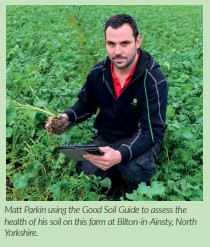
‘World’s Most Comprehensive’ Online Soil Health Guide Launched
An online soil guide aiming to become the world’s most comprehensive resource to help farmers improve soil health
and increase the efficiency and profitability of their businesses has been launched.The Good Soil Guide – a collaboration between Yorkshire Water, Yorkshire supply chain consultancy Future Food Solutions and expert soil scientist Neil Fuller – is a free-to-access, online encyclopaedia, specifically designed for use in the field. The huge database contains extensive information, empirical data and advice on how to improve soil health, increase soil organic matter (SOM), diagnose and treat problems with soil and crops, and help farmers to reduce carbon emissions. It is a live guide, enabling farmers, agronomists, and other industry professionals from around the world to share their knowledge by adding to the already extensive resource. The idea for the Good Soil Guide was born when Yorkshire Water Catchment Strategy Manager, Andrew Walker, met with Neil Fuller at an event held by Future Food Solutions.

In 2014, Mr Walker helped initiate a project bringing together landowners and stakeholders in the English uplands to facilitate better environmental outcomes for blanket bog land and was keen to try a similar approach in the lowlands. He said: “The project in the uplands proved that by engaging with landowners and other stakeholders and taking a collaborative approach, you can create outcomes that deliver for all. “We wanted to take this model and apply it to the lowlands to solve issues around sediment, nutrients and pesticides leaching into the watercourses and having a detrimental effect on water quality.
“We knew that working with farmers to address this would bring them huge benefits in terms of keeping soil and expensive fertilisers and pesticides where they should be – in the field.
“For us, it was a case of improving water quality, so we got our heads together and created the Good Soil Guide to help achieve these aims.” Mr Walker added the guide was the sum of Mr Fuller’s 40 years of experience in practical soil science compiled into a single resource, which was funded by Yorkshire Water. “Essentially, it focuses on improving soil health and increasing soil organic matter,” Mr Walker said. “Doing this gives the soil a more robust structure, meaning far less is lost to sediment, nutrients and pesticides are held on the field, and as the soil can absorb more water, incidents of flooding are hugely reduced.”
Mr Fuller said the resource had been created to help farmers get the best out of their most valuable asset – soil. He added that it was a holistic guide, looking at all aspects of soil health, and had been specifically designed for use in the field. He said: “The Good Soil Guide is full of soil data derived from cover crop trials, different tillage methods, practical experience and much more. “By using it, farmers can compare soil samples from their fields with pictures in the guide and diagnose issues such as a lack of nutrients or depleted soil organic matter. They can then use the contents of the guide to put that right. “It is not written in an academic or scientific style. The information is presented simply and clearly and in a mobile-friendly format, so farmers and agronomists can access it whenever and wherever they need it.”
Mr Fuller added that the guide also included advice on carbon management, including sequestering carbon to reduce atmospheric C02, increase soil organic matter and help farmers move towards net zero. “The key to carbon net zero is good soil health,” he said. “By managing soil in a way that increases its health, everyone wins. The farmer saves money, increases yields and reduces emissions; there are huge environmental benefits including removing CO2 from the atmosphere, and the consumer benefits from better quality food. “The Good Soil Guide is a powerful tool in enabling British agricultural to make these changes.” Food consultancy Future Food Solutions co-ordinated the creation of the Good Soil Guide.
The guide is free to use and has no links to agribusiness, meaning all the information and advice contained within it is unbiased.
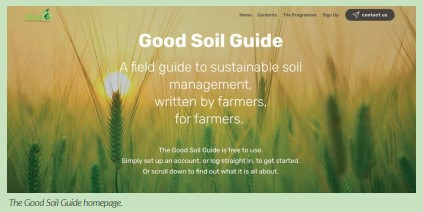
Future Food Solutions is already running the world’s largest renewable agriculture project – the Sustainable Landscapes Humber Project – in East Yorkshire, in partnership with Yorkshire Water and frozen food specialists Birds Eye. The Good Soil Guide extends this work, opening up cutting edge soil management practices to farmers across the globe.
Paul Rhodes, director of Future Food Solutions, said the guide was a huge leap forward in helping farmers to grow more sustainably.
He said: “Our understanding of soil has moved on dramatically in the past five years and what we’ve learned is that to get the most out of it, we must treat it as a living bio-system. “The Good Soil Guide has been developed to help farmers do this and realise a dramatic increase in soil health. “Making that shift has huge, positive consequences in terms of reducing steel and diesel use, improved yields, better efficiency and better profitability. “It will also help farmers reduce emissions, and with the target of net zero just 20 years away, that is something we all have to start taking seriously.” Matt Parkin, who farms at Bilton-inAinsty near Wetherby, North Yorkshire, is taking part in the trials to improve cover crop establishment. He said: “I am currently participating in some interesting cover crop trials as I think soil management is becoming steadily more important to an integrated farming approach. “As a dedicated soil tool, the Good Soil Guide can only help with this.”
To access the Good Soil Guide, go to www.soilguide.co.uk and create a free account.
-

Drill Manufacturers In Focus…
DRILLING FLEXIBILITY UNDERPINS PROGRESS TOWARDS GREENER FARMING

Yorkshire arable farmers Julian and Scott Hopwood are taking important steps towards a more sustainable farming future.
With 500 acres of relatively light Vale of York land, growing a rotation including winter and spring cereals, oilseed rape and breaks such as spring beans and peas, they have started using cover crops and non-inversion establishment to improve the farm’s environmental credentials. Far from a radical change of direction, their approach is a steady evolution, and one that has avoided the need for any major investment in specialist machinery. A key driver for change has been Julian and Scott’s active participation in the Sustainable Landscapes programme. This is an initiative that is being delivered by a range of supply chain partners with the aim of delivering innovative food production solutions for the benefit of the environment, consumers and farmers.
“Involvement in Sustainable Landscapes has encouraged us to take a fresh look at the way we farm and is introducing new ideas that we’re keen to adopt,” says Julian. “With the changes in farm support policy coming with ELMS, it’s very clear what direction we need to go. Factors such as carbon capture, water quality and soil health are going to be increasingly important and will impact on the way we farm in the future.”
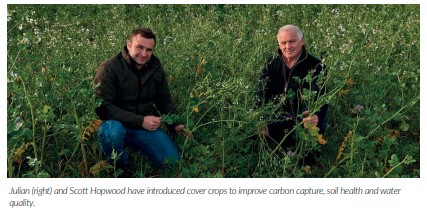
In many ways Julian and Scott are ahead of the game, having been farming for some time at Grimston Grange with soil health in mind.
“We’re farming land that’s typical of the Vale of York, ranging from blow-away sand to medium loams at the heaviest, so we’ve always been conscious of the need to incorporate fibre to maintain soil organic matter,” he explains. “We’ve always swapped straw for farmyard manure, spreading that as much as we can, and more recently we’ve been using sewage sludge as an additional way to import nutrients. “Cover crops are another way to improve the soil but are still a relatively new venture for us. Nevertheless, we’re already seeing benefits and I can see them being a significant part of our future farming policy.”
It’s a future that Julian expects will also involve increasing amounts of noninversion establishment, something he’s been able to achieve using the same power harrow/drill combination that works so well after the plough. “We have a Kuhn Venta 4030 pneumatic drill mounted on a Kuhn HR power harrow and this combination has been a real game-changer when it comes to establishment flexibility,” he adds. “With the disc coulter system on the drill, we can operate in a wide range of conditions, from minimum tilled to ploughed ground, with great control of seeding depth from the tractor cab. The quality of the establishment is very visible, with crop covers being complete and very even.
“We always use it in conjunction with the power harrow, which has a tine spacing design that helps to avoid jamming and a rubber packer roller. The power harrow has additional benefits such as quick-fit tines and is also fully controlled from the touch-screen in the cab. “The combination has transformed our drilling capabilities and allowed us to introduce non-inversion establishment without having to invest in different machinery.”
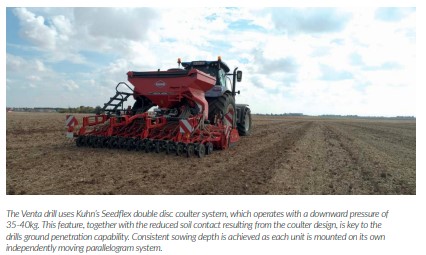
To date, non-inversion techniques have been used to establish winter wheat following oilseed rape and have also been used in establishing rape when conditions allow. Where rape is following wheat, the usual practice is to apply sewage sludge, with being disced in with stubble before sub-soiling and then going straight in with the Venta drill/power harrow combination.
Cover crops
Cover crops have been introduced with carbon capture, soil health and water quality very much in mind, with some varied mixtures now being grown ahead of spring cropping. Typical mixes include species such as fodder radish, vetches, black oats, clover and phacealia, offering a range of rooting depths and leaf architecture to maximise the benefits for soil health. Julian is also growing oil radish, which has additional benefits in reducing the impact of harmful free-living nematodes.
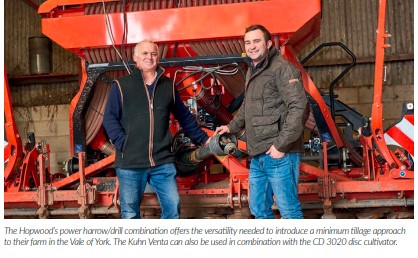
All cover crops are flailed before being ploughed in ahead of spring crops, adding substantial organic matter and nutrients to the soil.
“It’s still early days for us with cover crops, but we followed them with spring peas and spring beans last year and did see benefits,” says Julian. “Most notable was the way these crops came through the drought conditions so much better than we’d normally expect.”
Incorporating cover crop residues is just one of the jobs for the plough at Grimston Grange, which remains the primary tool for cultivation despite the increasing use of non-inversion techniques. As with the power harrow/drill combination, Julian and Scott have opted for strength and good structural design with a Kuhn MultiMaster 183. “The plough is still an important part of our cultivations and we’ve chosen this machine for its build quality and its balance,” adds Julian. “We use it with a 16 inch furrow width and usually with a packer roller, and can switch between using it on-land or in-furrow depending upon conditions. If we’re going to plough, as we plan to continue doing where required, it’s important we do as good a job as possible, so a machine that is well designed and adaptable is critical.”
Winter wheat at Grimston Grange typically achieves around 3.5 tonnes/acre, mostly grown for the feed market though some does go for milling. Winter barley also yields well, averaging in the region of 3 tonnes/acre, though this can be lower in a poor season and higher when everything comes right. Oilseed rape can be a challenge, with the threat of flea beetle ever-present, so the strategy is to drill early, and never later than the end of August. Spring cropping is generally aimed at the premium markets, with barley usually achieving malting grade and peas and beans grown for seed.
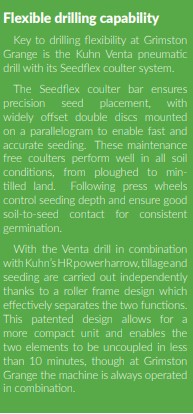
-

Farmer Focus – Adam Driver
Déjà Vu?

Another fun drilling season….I am pleased to say we are drilled up bar about 50 hectares on some poorly drained blackgrassy land which was always on the list to do last. This will now be better off as spring barley. Last season was very difficult, we did not get enough drilled and were always waiting for the promised week of good weather which never materialised. However, the silver lining is that we learnt a huge amount on how to deal with a wet autumn, no tilling on clay. In the long run I think this is a blessing in disguise and which offer more value down the line compared to one harvest with not enough wheat in the ground.
We started drilling on 19th September, getting in about 300ha of winter barley and wheat before the weather broke, on the 23rd the same day as last year. This was all drilled with the sprinter on 2 inch dutch points after spring barley an spring oats. After the rain broke, we had 260ha of cover crop land to get in, as well as 130ha of cultivated land. The cover crop land, after OSR and first wheat consisted of linseed, buckwheat and sunflowers. We managed to chip away in small breaks in the weather for the next month. The cover crop kept the drill running clean and crops look reasonably well now.
There was a lot of slugs to deal with however I hope as we get deeper into this style of farming they will diminish with better soil structure and more beneficials. It was really a revelation being able to drill into nice soil whilst anyone who had cultivated were doing their best to maul crops in, probably causing more soil damage to add on to what was caused last year. The fields now walk beautifully (apart from the odd hammered tramline and headland corner). Water is percolating through the soil profile and the number of worms is staggering.
One thing that has become noticeable in the last few days is that any winter barley crops in the area established direct or with a shallow cultivator pass are generally looking green and well, whereas those established with deeper tillage and ploughing are beginning to show up yellow areas and multiple wheeling’s. More proof that aggressive tillage can often be counterproductive. Our area of cultivated land all ended up being broadcast and harrowed in. It is actually emerging well however the lack of structure in the soil is noticeable when walking, and there is more blackgrass pressure. Not ideal and hopefully the majority of our crops established with no till are proof that this cultivating was recreational.
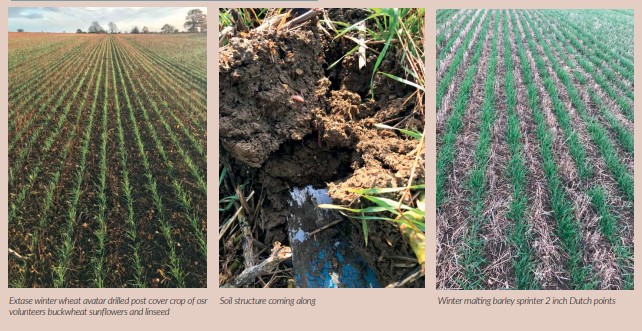
The rape is generally looking okay, there is about 25ha we will right off and put spring oats in. It has been noticeable the OSR has been much harder to establish after spring barley, compared to early winter wheat and winter barley. Our low risk approach to OSR means the only cost lost on the poor couple of fields is a dose of slug pellets and a £5/ ha graminicide. As all OSR was sown with a companion crop I feel the 30kg/ha N applied at drilling will have been utilised by these, even if the rape itself did not get going.
Regenerative agriculture is reaching an interesting point in its development in the UK. It is becoming more mainstream. This is bringing to the fore some notable issues. What was once a farmer led movement is becoming increasingly saturated with various companies offering “regen” solutions. Unfortunately, these solutions often take the form of various products. I am not saying none of these products don’t ever have a use. However, as this type of farming becomes more mainstream, there is an increasing number of farmers wanting to do it with a large gap in their knowledge.
This leaves opportunity for companies to find a gap in the market to offer advice and products. The issue is if farmers have not gained the full understanding of the 5 basic principles of regen ag they are essentially sitting ducks for companies offering X service or product Y. As the money transfers from conventional to regenerative agriculture we have to be very alert to whom we trust. Many companies offering advice also sell all manner of products so due diligence is needed when choosing who to take advice from. The other worrying aspect of all this is what do these so called “biological/ biostimulant” products do?
They are unregulated and high margin. At least with pesticides (although we don’t want to use them) we know what they can achieve and we also know the detrimental affect the have on the biology we are trying to nurture. I guess as farmers we are always trying to fiddle and improve things however, I am not convinced spending loads of money on gear we don’t really understand is the way to go, despite what the salesmen say. We are however trying a bio-stim, it is cheap and has had good results in numerous independent trials. Far beyond anything else I have seen (in fact many of them seem to have a detrimental affect on yield and do not produce positive MOIC).
As said earlier, some of these things may well have a place. But let us remember the key points for regenerative agriculture. The foundations of the system and most importantly soil. I would strongly urge anyone to understand the basics and get comfortable with them first, that is where the real gains are made. I fear if you simply “outsource” your decision making to vested interests it could end up with disappointment, a bamboozlement of big words and simply replacing a chemical bill with biologicals and high markup trace elements (especially some of the more obscure examples I’ve seen recommended for baffling reasons). The regen movement is supposed to be an alternative to the status quo of high inputs and expensive costs, keep in mind any of these companies offering advice on regenerative farming and selling various products on the back of that is “serviced agronomy mark 2”.
The best investment you can make into making a switch to regenerative farming is in yourself. Read as many books on the subjects as possible, trawl the forums, watch twitter, listen to podcasts, speak to the farmers doing it, download webinars. Find truly independent advisors or at least be clued up when using ones that may have an ulterior angle and get advice from more than one. Use your own mind and trust yourself. If you do not put the effort in you will simply carry on filling up other people’s coffers. Always be wary that the majority of people in this industries job is to make money from you. Get the basics right and the rest will follow.
-
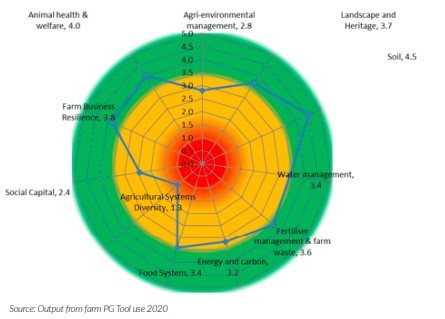
What’s In A Name?
Written by Liz Bowles from the Soil Association
The role of verification, certification and labelling to drive meaningful positive impact on our food production systems
Measuring performance
Amidst the explosion in interest in how farmers can achieve environmental best practice without negatively impacting food production, an increasing number of schemes, labels and tools for measuring performance and recognising best practice are starting to emerge as well as a ballooning offering of ways to measure what is happening on farm.
Right now, it feels pretty confusing for many farmers to know how best to interact with the options becoming available and indeed to know whether the propositions which they may be faced with are the most rewarding. What is clear is that never have so many people been so interested in what farmers are doing on their farms. This is down to the heightened concern over how we are going to reverse the climate, nature and health crises we face and the vital role which farmers can play in this through how they farm. In addition, many of the businesses who buy from farmers want to be able to tell their customers about the positive environmental performance of their suppliers. To do this they need ways to measure that performance and to know what good likes.
’You can’t have a target without a baseline’ and ‘you can’t improve it if you don’t measure it’ are two stock phrases from the advisor’s handbook, which can be used to justify lengthy data collection and comparison exercises. The pledge for net zero carbon farming, carbon sequestration targets and even increased productivity to reduce emissions are all being discussed but in order to achieve an outcome we need to know where we are starting from and what improvements are being made over time. There are now a range of tools and excel spreadsheet-based systems available such as AHDB benchmarking, three industry recognised carbon calculators (Farmer Carbon Calculator, Agrecalc and the Cool Farm Tool) and ORC’s Public Goods Tool, all of which can be useful and are aimed at farmers rather than other industries. All can help to determine the farm baseline and if used regularly can provide information on change and improvement.

Carbon footprint figures are increasingly being asked for, and there are good tools available, with slight differences between them. It is now possible to measure the benefits hedges and trees on farms bring, which historically may have been seen to have little economic value. One consequence of these carbon footprinting tools is that farmers can now say they have proof of carbon sequestration which could lead to the ability to receive payments for the carbon sequestered. What is still preventing this market from taking off fully in the UK are agreed metrics on the measurements although the FAO has now come up with a protocol for measuring soil carbon.
Biodiversity and environmental measurements can also be assessed by tools like the Public Goods (PG) tool with many others in development. The PG tool analyses stock numbers, yield and inputs information, as well as questions about on- farm practices, wildlife and environmental actions to produce a graphical interpretation on your farm. The impact of changing farming practice can also be assessed using the tool. The Soil Association has been trialling a version to assess public good provision in a Defra test and trial in the Clun and River Exe catchments. We will all perhaps have to start getting used to seeing diagrams like the one below to present farm performance:
New terms, new farming systems
Alongside our rapidly expanding ability to measure and benchmark environmental performance a number of new terms are coming into common farming parlance. We are used to conservation agriculture and organic farming, but new terms which are becoming increasingly prominent are agroecological and regenerative farming, together with heightened interest in the ability to verify, certify or label production from farms which are following these newly coined farming systems.
What is agroecology? – Agroecology is not well understood. Put simply agroecological farming systems take a whole-farm approach that works with nature, rather than against it, benefitting the environment, food quality and human health. Organic farming is the best known and the only accredited example of agroecological farming.
Alongside farming systems agroecology also involves us in looking at our food systems – what we eat, how we use food waste and how we as consumers interact with food producers focussing on more local and hyperlocal food supply chains. Maximising diversity in all things is a key component of agroecological farming systems including the integration of trees into the farmed landscape.
A farm following an agroecological farming system would typically do all of the following – reducing inputs, non-chemical pest control, harnessing ecosystem services instead; promote healthy, living soils through soil nutrient cycling, high carbon soils, biodiverse soils, use of green manures; farming with trees ; rotating and integrating crops, encouraging diversity and recycling nutrients rather than introducing external inputs.
Regenerative agriculture is a holistic philosophy that aims at positively influencing bio sequestration, biodiversity, ecotoxicity, climate resilience, water systems, micronutrients, and ecosystem services. Standard practices include no or min till, cover cropping, multi-use systems, agroforestry, rotational farming, precision agriculture, integrated pest management, and intentional use of inputs that are landscape specific. Again, the best-known UK example of such systems which has specific standards which are inspected against is organic farming.
Regenerative agriculture is not a ‘one size fits all’ prescriptive practice, instead it looks at the combination of methods that support resilience as well as build and nourish our ecosystem. Over time, regenerative practices are said to be able to increase production and naturally reduce the need for external inputs. When these regenerative practices are implemented successfully, the health of the agriculture ecosystem and farmer economic stability can be improved.
Labels, verification and certification
Alongside these new terms for farming practice there is also focus on how possibly value can be added for farmgate produce from such systems. Mechanisms include certification against standards, verification of farming practices and use of labels for qualifying farms and products. There is also debate on how best to deliver improvement in farming practice to address the climate, nature and health crises we face. It may well be that supporting farmers to benchmark performance in relevant areas and to seek rewards from new sources such as for carbon or biodiversity offsetting might be more helpful, driving cross sector collaboration to draw farmers into a new approach for land and livestock management. The need to establish a common language and a standardised approach to demonstrating farm environmental performance is becoming clear. There is also an increasing appetite for precompetitive industry collaboration to avoid both duplication of effort and unnecessary resulting confusion which could create barriers for farmer buying and the system change which is needed.
Alongside this debate there are several new initiatives starting to emerge in this space:
The Regenerative Organic Alliance has defined regenerative agriculture into a set of standards which must be met in order to become ‘regenerative organic certified’ (ROC). ROC starts with organic as a baseline then builds on the US organic legislation and consists of three pillars: Soil Health and Land Management, Animal Welfare, and Farmer & Worker Fairness. ROC has just completed its first pilot phase and is set to launch as a global certification scheme soon.
The Regenagri platform was launched in June this year to promote holistic farming techniques that increase soil organic matter, encourage biodiversity, sequester CO2 from the atmosphere and improve water management. This initiative is led by international agriculture and food chain auditing and certification body Control Union.
To help develop this initiative in the UK, a governance group has been established to advise on models to measure the impact and benefits of implementing regenerative systems through soil health, biodiversity, value systems and carbon footprints. Agrimetrics are the software partner for the initiative. Other governance members include the Cool Farm Alliance, FWAG, the Soil Association organic group and the Sustainable Food Trust. The Soil Association joined this group in the spirit of collaboration to see if it is possible to agree common frameworks for the metrics for assessing natural and social capital.
The Soil Association is building on the ‘Innovative Farmers’ approach that has been so successful in supporting farmer led research, and is developing a largely digital hub to enable farmers to share their improvements in the delivery of public goods…what’s working well’, and to benefit financially from doing so. This hub will focus on a set of practical iceberg indicators which farmers can report against periodically and which will allow them to identify how best to improve their performance against these metrics. We have made a start on this with a project we started in the summer called Carbon Assets for Soil Health (CASH) which will improve our understanding of how farming practices contribute to soil carbon stocks. We are still keen to hear from all farmers interested in being involved and who have historic soil analysis information. You can contact us on producer.support@soilassociation. org to find out more.
-

Putting A Price On Regenerative Farming
Written by Thomas Gent from Gentle Farming

Regenerative Agriculture is becoming a buzzword in the non-agricultural business community, sustainability and the circular economy will become more impactful in the coming years. Consumers are now aware of the eco credentials of the businesses they are spending their money with. This is driving businesses across the country to consider their own environmental impacts. Major companies are committing to achieving net zero in the coming decades. UK farming and food production has a significant opportunity to play an important role in this.
I am Thomas Gent, we have a family farm in South Lincolnshire and have been farming regeneratively for around 12 years. I have founded Gentle Farming. Gentle farming is an organisation looking into this opportunity and how we can connect farmers with businesses who are interested in supporting regenerative farming. The health of our soils directly impacts the health of society. We began by focusing on soil carbon and soil testing but quickly realised this is a complex problem and there are currently no concrete answers. Soil testing is notoriously inconsistent and volatile. However, it will be a crucial part of the picture as methods develop. This led to the thinking of regenerative agriculture as a whole farm system.
Using the regenerative agricultural principles, we are creating a brand and giving business the opportunity to invest and play a part in this important work. We are offering businesses the opportunity to work with a group of the most innovative and prominent UK farmers leading the way in regenerative practices. Using online calculators, research and previous soil testing we can build a picture of the amount of carbon our farms are storing and sequestering each year. I believe carbon offsetting money from the private sector will become a major part of the payments farmers will be able to receive in the future.
We are working with several organisations including a group of leading universities and UN climate change international partners to find a certified solution to carbon offsetting. It is looking very likely that this may be certified within the year. As soon as these pilot schemes come into action, we will be in the position to sell certified soil carbon credits.
But until this happens we are focusing on the corporate social responsibility sector allowing us to build a system and a brand for working with farmers championing regenerative agricultural practices. Corporate social responsibility will also play a large part in the potential payments farmers could receive for farming regeneratively. With subsidies coming to an end this could be an opportunity for farmers to access funding. Businesses will want to be able to work with an established credible community of farmers. Our potential group of farms are spread across the country and so can be local to any business. We plan to facilitate the opportunity for clients to visit farms to learn hands-on what we are doing day in and day out and to share our values.
This is a huge opportunity for UK farming and if we act decisively and quickly we can become actively involved in the market and the conversation around pricing. Through this opportunity farmers can have a significant impact in mitigating climate change, working towards net zero and providing many environmental benefits. The possible funding streams are an incentive for farmers across the country to implement sustainable farming practices to the benefit of all.

-

Farmer Focus – Steve Lear

We didn’t think we would get a wetter autumn than last year……we were wrong.
I definitely remember farmers telling me that last autumns rain was only a freak occurrence and it wouldn’t occur twice in as many years. Well nature had other ideas and it has meant that after 130mm of rain over the first weekend of October we again have very little winter crop in the ground. Once we have that much rainfall on our clay soils its pretty much game over when it comes to drilling a profitable crop. Most of the farm bar a little bit of winter barley and a little winter wheat will again be going into spring crop. This in the past would be rather devastating for us but since changing to zero till we have managed to turn a half decent profit from spring cropping. With little if any pre emergent herbicides needed, plenty of composted manure to reduce our nitrogen use and the ability to put some fields down to whole crop for our cattle has shown that spring cropping can work very well under our new system. It will also be a great benefit in terms of blackgrass control to have fields that have only known a spring crop for the last 3 years.
Having said that I do want to continue growing good winter crops so we have had to look at what we can do to prevent the rainfall from stopping us. We have come up with a four point plan.
Drainage
The current wet autumn has made us realise that our drainage needs to be better. Ill be the first to admit that in the past our drainage systems have not been adequately maintained. Ditches have been left too silt up and drains have steadily blocked up. All these things are great for the wildlife and biodiversity on the farm but not so great for our bottom line. Under cultivation we probably got away with our badly maintained drains, but since we changed our system we have realised that we need an efficient way of allowing the clay too get excess water away. We are currently partaking in a large amount of ditching and finding tile drains we didn’t even know we had. We purchased a small drain jetter to clear our outfalls and are making great progress. I think we will see the benefits of this for years to come and am sort of kicking myself we didn’t do this work before. The whole process has shown me that the chaps who put these drains in many years ago really knew what they were doing and that we will be maintaining the fantastic system they put in place properly from now on.
Green cover before autumn drilling
Until now I have always thought that there is no point in growing a cover crop in front of winter crops. After speaking to a few other more knowledgeable individuals I’ve come to the conclusion that actually a fast-growing cover can keep the drill rolling in the autumn and prevent soil from sticking to press wheels, openers and every other part of our drills it feels like connecting itself too. On top of this, if we still can’t get it drilled, it can stay in place and reap all the benefits of a cover crop until we return in the spring.
Continue to increase our infiltration rate
We have already noticed that our infiltration rates are getting better under zero till but we need to get even better. To do this we will keep on growing cover crops, use grazed perennial in the rotation, keep adding carbon back to the soil through manure, and try to keep off the soil when condition aren’t right. The last one of these isn’t always possible, so we have purchased a small low disturbance subsoiler. I don’t intend to use it a huge amount. But if we do cause more compaction than can be taken out through using a cover crop we need a way to get oxygen back into the soil to enable the microbes and worms to repopulate.
Bring our drilling date forward
We have always delayed drilling here until mid October due to blackgrass. We are now getting on top of the dreaded weed and I think its time to gradually bring the drill date earlier. All the seed that comes through now should have germinated at the surface so should get hit pretty hard by our pre ems as well as showing a green leaf earlier than a buried seed. On top of this ive been thinking about bringing OSR back into the rotation. We haven’t grown it for 6 years now due to flea beetle pressure. If we can grow it with very little cost until we actually know we have a viable crop then it will be back for us. It offers an early drill date, different set of chemistry and if it fails we will pretend it’s a cover crop. I think the main down side will be the slugs, I’ve enjoyed not using slug pellets since we last grew it.
On a more positive note our whole cropped oats (under sown with grazing leys and herbs) are proving a favourite for the cattle. The intakes are up and the silage has analysed really well. The only thing it was lacking in was protein. This year we are planning on companion cropping the oats with either vetch or peas to help increase this. I’m hoping to grow this using only a predrilling dose of round up and an application of FYM, it will be interesting to see whether the oats gets enough nutrient from the manure, legumes and our soil biology.
Stay safe, keep smiling and hopefully we can start meeting each other again in the near future. Im certainly looking forward to the first agricultural show I can get too when this bloody virus gets the message and does one.
-

For When The Chips Are Down
PRESERVING UK SOIL MICROBIAL BIODIVERSITY FOR SUSTAINABLE AGRICULTURE
Written by Wayne Coles at CABI

Scientists from the UK’s foremost agricultural research institutes have teamed up to create a new UK Crop Microbiome Cryobank (UK-CMCB) to safeguard future research and facilitate the sustainable yield improvement of the UK’s six major food crops including barley, oats, oil seed rape, potato, sugar beet and wheat. CABI, who is leading the BBSRC project, joins researchers from Rothamsted Research, Scotland’s Rural College (SRUC) and the John Innes Centre, in developing a ‘Noah’s Ark’ of UK microbes from crop systems that will form the first publicly available resource of its kind anywhere in the world. Scientists from the University of East Anglia (UEA) and the James Hutton Institute will also be collaborating on the initiative which will use state-of-the art cryo research techniques to preserve important crop microbiome samples from different soil types across the UK.
The UK-CMCB will provide a facility for researchers to source data and samples for their work, including living microbial material as well as genomic and metagenomic sequences (DNA) from different microbiome environments, including the rhizoplane.
Microbiomes are all the microbes present in any one ecosystem, in this case those associated with the crop plant, whether they are present in the leaves, seeds and stems or in the bulk soil around the roots. A beneficial microbiome results in a healthy plant and an improved crop yield and better-quality food.
Dr Matthew Ryan, Curator, Genetic Resource Collection at CABI, said, “By preserving these valuable crop microbial samples, from a ‘unique snapshot in time,’ we will generate a representative, very valuable and unique resource from key UK crop systems that will become a vital resource for scientific researchers for generations to come. “We will be using UK-developed cryotechnology that uses liquid nitrogen to keep the samples secure at very cold temperatures. If you like, it is a ‘Noah’s Ark’ of UK microbes from crop systems and one that has many potential exciting uses.” All of the project resources will be fully characterised using advanced DNA sequencing techniques in order for scientists to discover what microbes – fungi, bacteria, archaea (single-celled microorganisms with structure similar to bacteria) and viruses – are there, what they are doing in the microbiome and what role they play in enhancing crop growth. The UK-CMCB will create a curated database of sample information associated with annotated sequences, meta-data and analytical tools for endusers.
This will be the first synchronised resource covering the total microbiome of a variety of crops in standardised soil types, supported by bioinformatics, microbiologists, plant health experts and world class storage facilities. Dr Tim Mauchline, Plant and Soil Microbiologist at Rothamsted Research, said, “Soil health is particularly important. If we can better understand the function of microbes present in our soils we can use this information to help farmers produce sustainable crops. There is a clear need to increase food production and reduce our reliance on chemical fertilizers and pesticides. It is imperative that biological solutions are found to help ensure the UK’s food security.”
Dr Nicola Holden, leading the genomics and bioinformatics team at SRUC and James Hutton Institute, said, “We are at a very exciting time in our understanding of microbiomes because of advances in deep sequencing capabilities, telling us not just about the composition of the microbiomes, but also informing on their functions. This resource will provide base-line data for how different crop types and the soils they are grown in impact the microbiome. Our ambition is to provide a comprehensive resource that will be used to optimise crop production systems.”
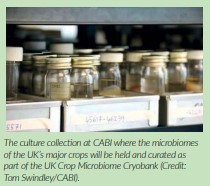
A further work package will be focussed on demonstrating the utility of the UK-CMCB for isolation of plant growth promoting bacteria and synthetic community construction. This will involve characterisation of the culturable microbiota associated with crop plants and the generation of crop-associated synthetic microbial communities (SynComs) and testing for their positive impact on plant growth. The microbial consortia generated through this work package will be added to the CryoBank and made available to the public.
Dr Jacob Malone, Group Leader, Molecular Microbiology at the John Innes Centre, who will be leading the SynCom construction and testing work said, “The UK-CMCB will provide a comprehensive platform to enable research towards optimising plant yield and providing sustainable alternatives to environmentally damaging agrochemicals.”
The 5-year project starts in October 2020 and will engage with CHAP, the UK’s Agritech centre for crop health and protection, academic researches and industry.
About CABI
CABI is an international not-for-profit organization that improves people’s lives by providing information and applying scientific expertise to solve problems in agriculture and the environment.
Through knowledge sharing and science, CABI helps address issues of global concern such as improving global food security and safeguarding the environment. We do this by helping farmers grow more and lose less of what they produce, combating threats to agriculture and the environment from pests and diseases, protecting biodiversity from invasive species, and improving access to agricultural and environmental scientific knowledge. Our 50 member countries guide and influence our core areas of work, which include development and research projects, scientific publishing and microbial services.

-

A Food Processor’s View…
DOES REGEN AG MATTER?
Written by Richard Pike from COOK

A broken System
My interest in sustainable food began somewhere in the mid 2000’s when, working for a UK farming group, we ended up importing lettuce into the UK, by air, in spring, to satisfy the demands of a major customer. I was shocked that no one seemed to be particularly concerned about the impact that sort of practice had. Two generations of shoppers have been taught to expect a 12-month supply of everything, from Strawberries to Cauliflower, for it to look perfect across the board and, worst of all, to pay as little as possible for it. You cannot fault the service given to the consumer because of this model but what about the producer and the planet both of whom get left behind in the race to the bottom?
About COOK
Luckily enough, just as I was about to go and become a beach bum, (until I found out that the pay wasn’t great), almost by accident, I landed a job at this fledgling, ready meal business that had a heart and was open to an alternative view. COOK has always had purpose at its core, back then the business was focused on quality above all else however it was already working hard to establish links to good local businesses and to put down a marker to determine what “purpose” actually meant. The business has always been focused on people, community, and quality because it’s the right thing to do rather than as a result of a strategic approach. Becoming a founding UK BCorp in 2014 really helped to cement our purpose into something tangible.
Protein is, and always was, by far our biggest single ingredient spend area. So naturally this is where we started focusing our efforts to effect change and animal welfare was the obvious starting point. We knew that this wasn’t the whole answer and that actually the problem was a much bigger multi- faceted one. One that required a focus not just on welfare or carbon but on other outputs like soil health, biodiversity, water quality etc. but we needed to start somewhere. We have now achieved five compassion in world farming awards and begun to work closely with a number of suppliers on how we can help improve in other areas and reduce our scope 3 emissions as well.
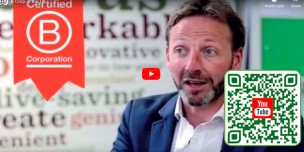
The Crisis
Of course, we are all fully aware of the climate crisis and the very real need to take bold and urgent action. We have set science-based targets and pledged net zero by 2030, in common with many other businesses. However, there are thousands who haven’t made any commitments at all, as of yet. We are also fully aware that agriculture gets a lot of the blame and that the work done to enhance and protect food security, safety standards and quality goes unsung in the face of environmental pressure. It is incumbent on us to help shepherd a change in perception and to educate consumers in order to improve. It’s also no longer enough anymore just to be sustainable, if we really want to change things, we have to put something back.

Commercial reality
People expect brands that they trust to be “doing the right thing” but what does that mean in reality? Someone, somewhere, must pay for doing business this way to understand and realize the true value of food.
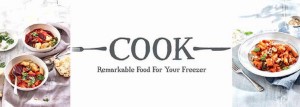
Sometimes it’s difficult for us in the industry to work out what good looks like so how on earth can we expect a consumer to differentiate between the provenance of a collection of shiny packs covered in claims in a supermarket aisle or to understand that just because it has a union flag all over it does not necessarily mean it’s the best option? Legal minimum country standards never go far enough and although there is a plethora of private standards in operation, all of whom perform a great service, many are focused on a single element of a complicated system. We are not experts in this space, we need to rely on those who are. We need a set of established and agreed guidelines or outcomes that allow us to work out equivalence and more importantly communicate that, in a simple way, to every stakeholder to uncover the true value.

The future
Any food business not truly active in the regenerative space within five years will risk being left behind and on the road to obsolescence. Getting behind efforts to put something back, we hope to be able to help influence and support all those we work with, to ensure that they are still viable and successful in the future. One of the key aspects of our business philosophy is relationships and we believe that they are the most important aspect of any partnership. The willingness to provide long term support and share the challenges is paramount to the success of both the producer and the customer if we are going to make any real difference. We always invite our suppliers to come and visit us to see how we use their product for two reasons.
Firstly, it connects the producer with the reason we are asking for the very specific things we ask for and how those things fit into our process. But more importantly to connect the people handling the product with the reality, that what’s before them is the result of someone else’s blood sweat and tears, whose livelihood depends on it and is not just something to necessarily cast aside because it doesn’t meet the expectation on the day. Where we can, we showcase the people who work with us to create a true connection from end to end and that’s what tells the story.
Someone once told me that we, as a retailer, needed to give the customer what they wanted but I disagree with the sentiment. It may be a little arrogant but it’s now time for us, as producers, to give people what they need and to tell them why they need it. We can’t turn the clock back 50 years, nor should we, but we can learn a lot from the experiences of our forefathers in realizing the true value of both food and the land that provides it to us. We need to play our part in educating our consumers to that effect. There is no silver bullet of course and no one size fits all solution but a truly sustainable future is ours for the taking if we are brave enough and I want to be able to tell my kids that we did our best to right the wrongs.
The system is truly broken but Regenerating Agriculture is part of the solution………….

-

Drill Manufacturers In Focus…
CELEBRATING 10 YEARS OF MZURI

On these pages you may be more familiar with Mzuri’s Trial Farm Manager Ben Knight, but in this feature, the man behind the machine Martin Lole, recounts the company’s history as they celebrate ten years of Mzuri strip tillage.
Developed in Worcestershire
2021 is a very special year for us at Mzuri, not only does it mark ten years since the launch of the first Mzuri ProTil drill at Cereals 2011, but it marks ten years since we started our journey into bringing environmental and commercial benefits to farmers far and wide.
The story starts in Worcestershire in 2005 after I purchased Springfield Farm.
Picking up from where the last occupant left off, I purchased an array of heavy cultivation equipment and an ample supply of horsepower to continue the conventional cultivations in earnest. It wasn’t long however, that I soon realised I was spending more time in the tractor seat and less time with my two young daughters, all whilst watching my input costs rise (from the farm that is!). After years of repeated attempts, it was becoming clear that farming in the way that I had known, as was typical for the area, simply was not going to be viable in the future. With the farm productivity at a low, I knew that if I wanted to continue, I needed to radically change my approach.
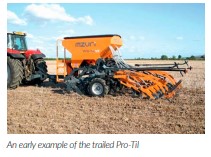
My biggest concern was the sheer cost of establishment coupled with insufficient yields to support the enterprise. Early on, I identified that my biggest source of costs came from the machinery and horsepower that I was so eager to buy in 2005, which in actual fact had done nothing more than drain my resources and limit the farms potential ever since. So that’s where I started, with a background in engineering from my Spearhead days. I developed the Mzuri Pro-Til to consolidate the passes of my conventional system to produce a seedbed direct into stubble, in one pass, and at a fraction of the cost. The results were astounding, and the sheer scope of the benefits were even a shock to me.
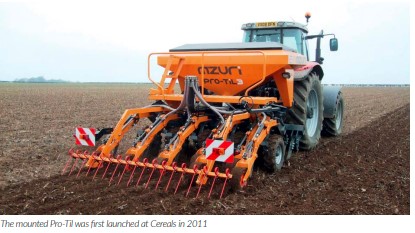
In fact, the impact on our finances were so stark that even the accountant raised a query with what he believed to be an oversight in the farm bookkeeping, but the reality was that we were consuming far less diesel, labour and machinery. From there, with the reduced cultivations of the strip tillage system, our soil health improved, our crops established better, and we retained moisture and structure which supported higher yielding crops. The difference really was night and day and remains consistent with what our customers report when converting from similar plough-based systems.

Expanding the sales network
Since the Pro-Til’s first outing at Boothby Graffoe, we have gone on to build a network of customers and dealers across the UK, many of whom are still with us today. In 2013 we expanded our export market into Europe and from there the Mzuri system is now sold in more than 20 countries, spanning four continents. I believe it is the Mzuri system’s universally resilient approach that has gained it notoriety across the world. From the harsh winters of Eastern Europe, the short growing season of Scandinavia to the moisture deficit in Africa and challenges faced by New Zealand and the UK, the Pro-Til’s design and agronomic merits produce unparalleled seedbeds in a range of climates.
In 2017 we announced the opening of a manufacturing facility in Poland to meet the rapidly growing demand in export markets as a joint venture with Polish company AN-AGRO. The new factory was built in the Bydgoszcz region in Poland to service the Eastern and Central European customer base with interest being particularly strong in Poland, Russia and Ukraine. With production continuing in Worcestershire to service the UK and Scandinavia, the new site allowed us to free up some of our production in the UK to be more responsive to the rapidly expanding UK market.

The Greatest Accolade
We have been very fortunate over the years that Mzuri has been recognised across multiple platforms for our innovation, service and impact on the environment, and have been in receipt of awards both in the UK and further afield. From the IAgrE Ivel Award, presented to the Pro-Til Xzact as the best new innovation at LAMMA 2018 for demonstrating the most positive contribution to the environment, to the award presented to our service team for their excellent back up and support of our customers. We are proud of each and every one of them and I was delighted to be awarded the Blue-Ribbon award for Outstanding Contribution to Agricultural Machinery in 2019.
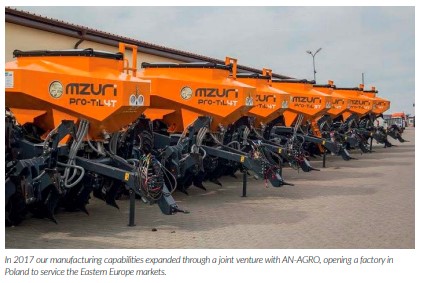
Mzuri’s biggest award however doesn’t come with a white glove or awarded at a star-studded ceremony. Our most valued award is the feedback we receive from our customers, and their experiences shared of a system that often yields transformative effect. From those who have been with us the full ten years to those who are just starting out, we are proud to work with each and every one.
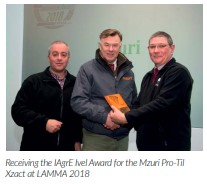
Mzuri: Future Proof Farming
With ten years under our belt, we have a firm eye on the future. As attitudes to soil management evolve and attract mainstream attention, I am pleased that Mzuri is well placed to deliver reliable solutions to the many questions now faced by growers. Through ‘boots on the ground’ trial and error, we have refined our system and captured useful information which helps us to inform our future practice and ensure our products meet the challenges faced not only today, but tomorrow.

Our continuing goal is focused around supporting our customers to achieve their sustainability goals in light of changing agricultural policy and regulation, extreme weather patterns and market volatility – through a combination of soil health, productivity, and cost saving principles.
One thing is for sure, we are looking to 2021 with excitement. It’s going to be big.
-
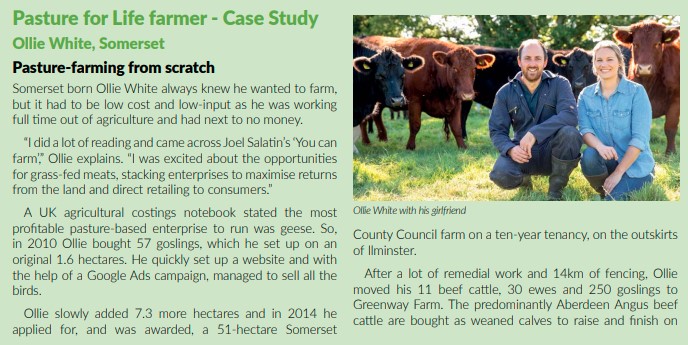
Pasture For Life Goes From Strength To Strength
Ten years ago The Pasture-Fed Livestock Association (PFLA) was formed by four farmers in the back room of a pub. Now, with more than 600 members and almost 2,000 consumer supporters, the organisation is looking ahead with confidence and excitement. Sara Gregson reports…
The PFLA is a diverse and growing community of farmers, butchers, food retailers, academics and consumers, who all champion the regenerative use of grazing animals to produce 100% pasture-fed meat and dairy. More than 100 members are certified ‘Pasture for Life’, which means they can use the Pasture for Life rosette in the promotion of their food products. Consumers can be sure the animals their meat and dairy came from only ever ate grass and pasture, no grains.
This year has seen the publication of a new mission and strategy in which the PFLA seeks to encourage more agroecological farming methods, promoting higher environmental outcomes and animal welfare and the production of nutritionally dense food.
The PFLA aims to achieve its mission through three strategic pillars:
• Culture – spreading awareness of the benefits of 100% pasturefed farming systems, through education, marketing and events, which will bring more people into the network
• Certification – providing a set of standards that act as a benchmark and developing market mechanisms so that certified products achieve premium prices and certified supply chains are suitable assured
• Collaboration – working with the UK farming community to ensure that pasture-fed principles are at the forefront of agricultural thinking and the PFLA benefits from strong networks with funders and other like-minded organisations.

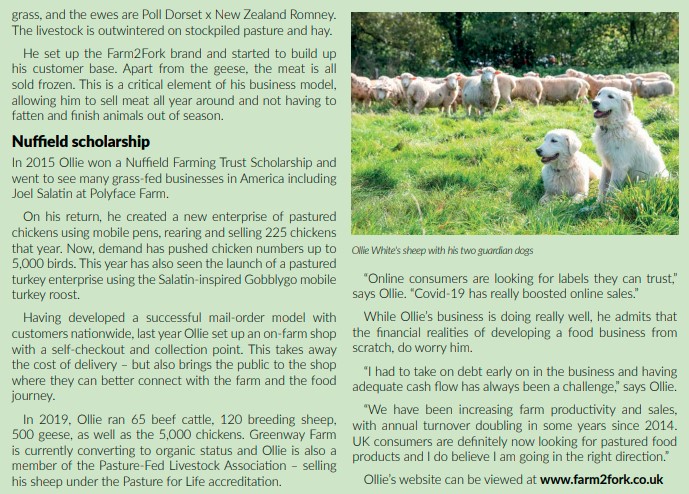
Regional groups
Building on a number of existing groups, the PFLA is now seeking to support its membership at a more local level. The Esmée Fairbairn Foundation has granted the association significant £250,000 seed-funding to help do this over the next three years. “As the PFLA has grown the collegiate culture of the organisation which developed naturally from the start, will be served better by a regional structure,” says the PFLA’s Jimmy Woodrow.
“We shall nurture existing groups like those in the South East and Cotswolds and seek to establish additional groups around the country including in the lowlands of Scotland, South Wales, Cumbria, Herefordshire, Wessex, Devon and Cornwall.
“Working locally will deliver many benefits, including being able to deliver more farmer-to farmer education, which acknowledges the variations in local traditions, soils, terrain, breeds and climate.
“Certified producers will be encouraged to work together to develop local supply chains, identify regional processing hubs and work with butchers and retailers to promote Pasture for Life branded food.
“The groups will also be encouraged to develop relationships with like-minded partner organisations spanning the farming, food and conservation sectors in their areas, such as the Wildlife Trusts and the RSPB.”
For more information visit www.pastureforlife.org
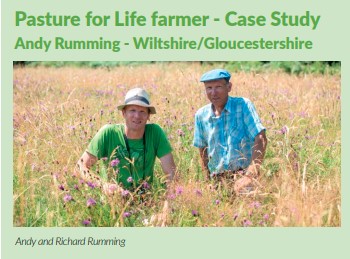
Grazing cattle bring multiple benefits
The Rumming brothers work with their father and uncle on their integrated beef business, which has seen financial returns per animal more than double after just four years. The farm business supports six partners and three generations at two farms, eight miles apart covering 153ha. The River Thames runs through the farm and the soils are predominantly heavy clay overlaying gravels. While not certified organic, no artificial fertiliser has been applied for 15 years. The grassland ranges from highly species-rich hay meadows to ‘improved’ pasture. “I used to be disappointed that our 100% grass-fed cattle were selling as heavy stores for as low as £700 at the livestock market at 30 months of age,” says Andy. “This seemed such a waste.” Andy and his brother Chris, already had experience of producing, processing and direct marketing free-range turkeys at Christmas. For this they had built a basic butchery and installed fridges in the old milking parlour, but these were only used for two weeks in December.
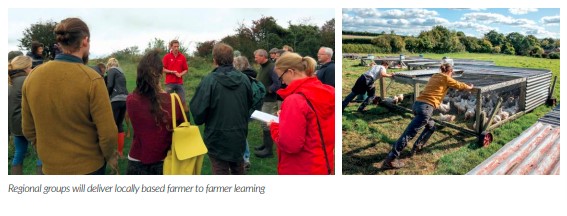
“In June last year we started to age, cut and pack beef animals in-house. We are lucky to live near to an affluent customer base and 80% come to the farm to collect freshly packed meat. Using a Mailchimp email is our key route for generating sales with most beef pre-ordered.”
Four years ago, Andy joined the Pasture-Fed Livestock Association (he says this is the best thing he ever did) and benefited from attending study group tours and taking part in the on-line forum.
Cattle and data
Eighty-five cross-bred cows are put to a pure-bred Stabiliser bull or a pedigree Hereford bull. The cows calve in two groups in spring and summer and are super fertile with 100% regularly scanned in-calf. The aim is for 96% of calves to be weaned per cows and heifers put to the bull and this is often achieved. Calving is at two years of age.
“I like data and my favourite metric is looking at percentage of bodyweight weaned standardised to weaning at 200 days,” says Andy. “The target is 50%. Neither herd has achieved this as a group, although individual cows have. No creep feed is fed and the animals are sold as 100% grass-fed under the Pasture for Life logo.”

The spring and summer calvers are cell grazed, moving completely every day with mobile water and Kiwitech semipermanent lanes and temporary dividing fences. The heavy soils mean animals are housed from November or December to the beginning of April and fed just on silage and hay. Straight after weaning, all youngstock is moved to Andy’s brother’s farm where Chris runs a rotational grazing system with 80 to 100 cattle at any one time. Finished cattle are now slaughtered at 18 months to two years at a carcase size of approximately 305kg for heifers and 335kg for steers.
“Direct retailing is not easy and we have to employ a butcher to break the carcasses down,” says Andy. “But the returns are much better than the £700-£1100 for stores we get. We are adding value with retail income of up to £2,500 or more per animal.”
Visit Andy’s website at www.andyrummingbeef.co.uk
